Yachting Monthly
- Digital edition


Sailing with solar power: A practical guide
- Duncan Kent
- November 13, 2020
The latest solar technology makes self-sufficient cruising much more achievable. Duncan Kent gives the lowdown on everything you need to get your boat sorted

SOLAR POWER ON BOARD
Solar power is fast becoming the most popular and economic method of keeping the batteries charged on a boat.
Particularly now that the efficiency of photovoltaic (PV) panels, charge controllers and batteries is improving every day.
Furthermore, the latest technology in regulators and charge controllers has brought about a noticeable increase in useable power output, so the problems of shading and non-alignment can be compensated for more easily.
Not only has PV equipment become more efficient and cost-effective, but many of the modern devices we want to use on a boat have become less power hungry.
This means it is now far easier to provide your entire yacht’s electrical needs, both 220Vac and 12/24Vdc, from natural energy resources – particularly solar power, even if you are planning on a fully electric boat .

Thinking carefully about how much power you need and how much your boat can accommodate is key to planning a solar array. Credit: Graham Snook
WHAT DO YOU NEED?
For instance, a boat with two new, good quality, deep-cycle house batteries of 100Ah each would supply 100Ah of energy to consume between charges, if you only use the recommended 50% of available charge between each charge cycle to protect the batteries.
From this you could run:
- a modern 12Vdc fridge (approx. 1.5Ah, or 36Ah over 24hrs),
- all LED lighting (say 20Ah per day),
- various small device chargers (20Ah)
- and a number of other items such as water pumps, TVs and stereos (25Ah/day)
- Totalling around 100Ah.
- For this you’d need 400W of solar capacity.
Of course, if you like to run a lot of AC devices off-grid such as hair dryers, microwaves, toasters and the like, then you’re going to need a DC/ AC inverter, which will take you to another level in power consumption terms.
But even then, with careful planning, solar could provide a large portion of the power you need before resorting to engine charging or a generator.
THE AVAILABLE SPACE
In practical terms, a modern 40ft monohull would have the space for around 1,200W of PV panels (cockpit arch, sprayhood top, deck), maybe 1,500W with the addition of a few portable panels for use at anchor.
The 1,200W of fixed position solar array could produce around 360Ah on a sunny summer’s day (zero shading) or more likely 250Ah on the average UK summer’s day.
So that’s enough for your 100Ah general DC consumption plus another 150Ah of AC consumption via the inverter.
Of course, to do this you’ll most likely need to increase your battery capacity to around 400-500Ah for maximum flexibility (you’ll need to store as much as possible during daylight hours), a typical figure for a 40-50ft offshore cruising yacht these days.

Get your solar charging right and you may never need to hook up to shore power
Typical daily inverter loads for a cruising yacht off grid might be:
- induction cooking plate (20min) 60Ah
- microwave (15min) 30Ah
- coffee maker (20mins) 25Ah
- hair dryer (5min) 15Ah
- laptop charger (2h) 10Ah
- or around 140Ah in total.
The trick is to monitor the batteries’ state of charge (SOC) at all times and vary your use of the inverter to suit.
For example, you might want to cook supper mid-afternoon, when solar is in abundance, and then reheat it in the evening when you want to eat it.
In some cases, when you’re cruising in warm climates such as the Med, you might end up with excess charge from your solar panels .
In this situation, many long-term cruisers devise a method of ‘dumping’ the extra energy by heating water for showers.
Do bear in mind if you’re planning to live aboard full time , then it’ll be a whole different story on cloudy days and during the winter, when inverter use might need to be knocked on the head entirely.
Continues below…

Eco friendly sailing: Best practice for green yachting
How easy is it to go eco friendly sailing? We look at the steps cruisers can take to minimise their…

How and where to go wild cruising in the UK
Planning to spend the night away from crowded waters can be truly rewarding but preparation is essential before you go…

Solar-powered boat crosses Atlantic
Then heads to UN climate conference
POWER DISCREPANCIES
There’s often confusion as to how much power you can harvest from a solar installation.
A PV panel is nearly always advertised stating its theoretical peak output power (Pw).
But in reality, on a yacht where there are limited areas in which to mount them, they will more likely produce a maximum of 60% of their peak output if mounted horizontally, increasing to 80% if tilted towards the sun and regularly adjusted.
The latter is rarely achievable on a boat, however, as even at anchor it can swing through an arc of 180° in wind or tidal shifts .

Flexible panels can be mounted on sprayhoods or awnings to add power when it’s needed at anchor or in harbour
INSTALLATION
Having trawled through hundreds of ‘deals’ to get the best price on the most efficient panels you can afford you now need to know how to install them to best fulfill your energy generation needs.
The output, even from the highest quality photo-voltaic array, will only be as good as the installation itself.
So following our guidelines should ensure you extract every last drop of energy from your investment.
PANEL MOUNTING
Sailing boats are not the ideal structure on which to mount wide, flat PV panels.
So before you go ahead and purchase what looks like the biggest and best, take a few minutes to decide on exactly where you can mount them, as this will affect what size and type of panels you should buy.
In many cases the first choice would be on an arch, davits or gantry aft, especially if you already have, or plan to fit one.

Dinghy davits, particularly on multihulls, can support a huge solar capacity
These allow a solid metal framework to be constructed that will be strong enough to take the heavier, more productive rigid PV panels.
You can also build in some form of adjuster to the framework that will allow the panels to be orientated towards the sun for the best performance.
With luck (or careful planning) a gantry will also keep them aft of the boom, thereby eliminating loss of output caused by boom shading.
The next most popular position for mounting the panels is on a cockpit sprayhood or bimini, although this will often mean using the flexible or semi-flexible panels, which are generally less efficient than the rigid ones for the same area.
ELEVATED MOUNTING
Alternatively, there are kits available for mounting panels onto lifelines, which can allow their elevation to be manually adjusted to a certain degree.

Pole-mounted panels can be used for maximum adjustability
Finally, panels can be fitted directly onto the deck by either gluing them down using mastic or attaching them onto a rigid support frame.
Once again you will probably need to use semi-flexible panels – especially if the deck surface is curved.
Rigid, glass-coated panels will obviously not be suitable for deck mounting in an area that is frequently walked over.
Don’t be tempted to drill through the panels, even along the edges, as this will invalidate the warranty and possibly damage the panel.

With solid panels, the ability to adjust the angle can add significantly to output
It might seem obvious, but the key to an efficient system is to avoid shading wherever possible.
It’s no good fitting expensive, high-efficiency PVs right under the boom as they’ll perform little better than the cheaper types.
Saying that, in good quality panels each cell will be isolated from the next by a series of diodes (one-way electrical valves), so that if one cell is shaded at least it won’t drag down the other cells within the same panel.
Older panels often didn’t have these, so the slightest partial shading caused the output of the entire panel to cease.
OVERHEATING
Another important factor that is often ignored when installing the panels is that of overheating.
If a PV panel gets too hot, which is quite likely if mounted directly onto a flat surface without an air gap behind, its output will drop quite noticeably.
To allow for some air circulation behind the panels it’s best to apply mastic adhesive in numerous large dabs.
This is best achieved by placing wooden spacer strips between the dabs until the mastic has completely cured, after which the spacers can be removed.
You might need some form of trim around one or more of the outside edges, though, if they are positioned where sheets and other lines might get caught under them.
Raising the panels up will also help water to drain off and thereby helping to avoid possible delamination from sitting in water for too long.
CHARGE CONTROL
A PV module cannot supply an electrical device directly due to the changeability of the sunlight, which in turns varies the current it can produce.
Therefore, it has to be connected to a battery, which stores and smooths its output.
Whatever the size of your solar array you will need to fit a regulator, or charge controller as they are now more commonly known, to the system in order to control the output and to help extract as much power from the panels as possible.
There are two types of PV charge controller.
The older designs, called Pulse Width Modulation (PWM) types, were fairly basic voltage regulators and simply output volts at just above battery level.
The latest controllers use Multi Power Point Tracking (MPPT) technology and can accept much higher input voltages (up to 240Vdc).
MPPT controllers can be up to 30% more efficient as they use the peak output of the panels to charge the batteries, even compensating for partial shading.
BEWARE FAKE GEAR
If you buy online do be careful to ensure you’re getting what you pay for.
There are a huge number of fake MPPTs out there, which are simply the much cheaper PWM dressed up with fake labels.
It’s hard to tell which is which, but the old adage of ‘if it looks too good to be true, it usually is’ makes good sense.
MPPT controllers are usually bigger and heavier than PWMs, but if in doubt call or email the supplier to discuss the pros and cons of their kit before buying.
If they’re not happy to chat and advise you then I would steer clear of their gear.
Some good MPPTs are made in China, but unless they have a UK supplier, I wouldn’t bother with them as you’ll have no follow-up advice.
To calculate what size controller you need simply divide the panel’s peak power in Watts (Wp) by the battery voltage, which will give you the maximum current (Amps) they could theoretically supply.
For example 240W/12V = 20A. Although it’s unlikely you’ll ever get near the peak output from any PV panel, it’s best to go for the maximum possible.

Induction cooking is now a reality on board, even without shore power
PV panels come with a short length of cable, usually around 1m long.
Some are supplied with MC4 connectors already attached but most only provide bare wires.
The latter can be easily extended using proper waterproof connections but thought must be given as to the current rating and voltage drop (usually max 3%) for the size of cable you intend to use.
If in doubt, bigger is better!
Panels can sometimes be ordered with the wiring on the back so that the cable can go straight below deck through a hole under the panel.

You may need to fit extra battery capacity if you want to run an inverter from solar charging
SERIES OR PARALLEL?
A commonly asked question is ‘should I wire my PV panels in series or in parallel?’
The simple answer is, if there’s any danger of frequent shading to one or more of the panels then install them in parallel.
If wired in series the shading of a single panel will drag down the output from all of the others in the same series.
PARALLEL IS PREFERRED
Most commonly, multiple panels are wired together in parallel to a single charge controller, with diodes protecting each panel from discharging the others should one become partially shaded.
With the advent of MPPT controllers, however, there can sometimes be a benefit to wiring two or more identical panels into a series bank, thereby presenting a higher voltage to the controller.
It’s worth noting that, like batteries, wiring PV panels in series increases the voltage only – the current capacity of the array remains the same as for a single panel.
‘Where’s the benefit of wiring them in series then?’ you might ask.
Well, the higher the voltage fed into the MPPT, the more consistent it will be with its output, which could, in some cases, prove more efficient than a parallel installation with PWM controllers.
It’s also likely to be necessary if you have a 24V domestic system.
SERIES WIRING
Series wiring is usually only done when the cable runs are long, as it helps negate the voltage drop caused by the resistance of the cable.
While a decent controller will have no problem handling the output from four or even five panels wired in series, it is often inappropriate for sailing yachts as shading just one of the panels will reduce the output of the entire series array.
If you need to do so in order to reduce cable runs then it’s best to split the panels between each side of the boat – a series bank on each side.
If you do this, then you would ideally fit a separate controller to each series PV bank and then connect their outputs together in parallel to the battery bank.
Note, however, that panels wired in series must all be the same types with an equal number of cells per panel.
Furthermore, the charge controller needs to be sized for the total of all panel voltages added together and the current rating of one individual panel.
Differently rated panels can be connected together in parallel but only if each panel has its own controller.
The outputs of the individual controllers can then be joined together to go to the battery bank.
BATTERY BANK QUESTION
Another frequently asked question is ‘Can I connect another charging source to the battery bank while the solar array is charging?’
The answer is yes.
Any decent PV controller will be protected against feedback from other charging sources.

Think carefully about where shade from mast, boom and rigging will fall. Credit: Graham Snook Photography
CABLE SIZE AND CONNECTORS
A frequent cause of reduced output from PV arrays is wiring that is too small.
The resistance of a wire conductor increases in direct proportion to its cross-sectional area, so go as big as is practicable for the least cable loss.
Each panel should be supplied with the correctly sized cables for its own maximum output.
But if you’re combining panels, either in parallel or in series, you will clearly need to rate the single feed cable to suit the maximum current available at theoretical peak solar output and to minimise voltage drop.
Likewise, the cable from the controller to the batteries should be sized to suit the controller’s maximum output current and protected with a fuse.
For outside it’s important to use exterior grade cable, which is double- insulated and UV-proof.
WEATHERPROOF CONNECTORS
And wherever possible use compatible weatherproof connectors (usually MC4) to those found on the panels rather than cutting off the plugs and hard-wiring them.
Field- assembly MC4 plugs are available, so you don’t have to drill large holes in the decks or bulkheads when feeding the cables through.
When joining more than one panel together try to use the approved multiway connectors; not only do they keep the wiring neat and tidy, but they also offer a greater contact area than budget terminal blocks.
If you have to use screw-type connectors make sure to fit proper ferrules to the wire first to avoid any stray wires in the multistrand shorting across the terminals.
When feeding a cable from above to below deck, try to go through an upright bulkhead where possible to minimise ‘pooling’ of water around the access hole.
Also, use a proper watertight deck seal that matches the cable you’re using.
If drilling through a cored deck you need to drill a larger hole first, fill it with epoxy resin and then drill the required size hole through the epoxy to ensure no water gets into the deck core.
Ideally, the charge controller should be mounted no further than 2m from the battery bank.
If you need to go further, you’ll require larger cabling to reduce the voltage drop.

A generous solar array will keep you self- sufficient indefinitely. Credit: Graham Snook Photography
CONTROLLER LOAD TERMINALS
There is often confusion over the ‘load’ output of a charge controller (often depicted by a light bulb) and what can safely be connected to these terminals.
Rarely explained in the manual, the load terminals should be pretty much ignored in a marine installation as the output on these terminals is usually very limited (10A max).
Some attach an LED light to them to indicate the controller is operating, but all your usual electrical loads should remain connected to the batteries with the battery terminals on the controller connected directly to that battery bank via a fuse.
It is possible, though, to control a high-current switching relay in certain conditions.

Parallel installation is more resilient to shading, but a series installation will increase peak charging outputs. A combination of the two offers some of the benefit of both
CIRCUIT MONITORING
Unlike most cheap PWMs, the majority of good quality MPPT charge controllers come with an alphanumeric LCD screen to let you know what is going on.
This can either be a remote display or simply one on the front of the box.
It’s obviously a lot better to have a proper numerical display than to rely on a few flashing LEDs to tell you when something’s not right.
So if your chosen controller doesn’t have one be sure to fit a battery monitor (the shunt type) into your solar circuit between the controller and the batteries.
It doesn’t have to be a very ‘smart’ monitor, just one that can display the voltage and current being supplied by the panels.
For smartphone addicts there are several wifi apps that will do the job remotely on your phone or tablet.
DEVICE PROTECTION
All good quality PV panels feature built-in diode protection between each cell to prevent a shaded cell from dragging down the productive ones.
In addition, there will be internal blocking diodes on the final output to protect the panel from polarity reversal and to ensure that the batteries can’t discharge back into the panel during the night.
The latter can be added externally, the former can’t, so check before you buy.
A fuse, rated just above the maximum current available, should be fitted between each panel and the charge controller.
Another fuse should then be installed between the charge controller’s output and the batteries.
In the case of multiple arrays, this second fuse will be rated higher than the individual panel fuses and should match the maximum current rating of the cable.
With this protection installed other charging devices can be connected in parallel at the battery, meaning the solar can be left connected even when you are hooked up to shore power and the battery charger is operating.
In some circumstances, however, this arrangement can affect the sensing of the battery by the charger, causing it to fall back into float mode.
If this becomes apparent it can be overcome by installing a manual/auto switch to disconnect the solar array when on shore power.

Check the flex of the solar panel is sufficient for your deck
EXCESS POWER DUMPING
A solar charge controller works by disconnecting the supply from the PV panels when the batteries are fully charged.
But for some full-time liveaboards in sunny climates that can be considered a waste, when the excess power could be put to good use – heating water, say.
This is commonly done using an inverter to supply AC power to the heating element.
Alternatively, you can now buy a 12Vdc element for your calorifier (hot water tank) and supply this directly from your battery bank.
Both of these methods would require a voltage sensitive relay (VSR) to disconnect the element should the battery voltage drop below a pre-set level.
Don’t expect boiling hot water, as there will probably only be enough spare power to take the chill off it before your battery bank reaches its lower threshold voltage.
A 600W/12V element will draw some 50A, from the batteries, whereas a 1kW AC element run through an inverter will need close to 100A.

A small, semi-flexible panel will be sufficient for keeping batteries trickle charged, but not for heavy use
RIGID, FLEXIBLE, OR SEMI FLEXIBLE?
Despite massive recent improvements in semi-flexible panels in recent years, the solid glass panels still offer a higher power density.
That said, they are heavier, more awkward to mount and can’t be walked on, so unless you have a dedicated gantry aft, you’re better off choosing the more rugged semi-flexibles.
Modules incorporating monocrystalline cells also have a better output than those with polycrystalline cells (that’s cells made from a single slice of silicon as opposed to layers of smaller pieces).
Output voltage also depends on the number of cells on the panel.
In the past this has commonly been 32, but now some 36 and even 40 cell panels are available.
That said, they’re larger, of course, so an array of interconnected smaller panels might be a better solution.
Module efficiency is now more often around the 20% mark, as opposed to 12-15% for older models and semi- flexible (up to 20° bend) are usually better than flexible (up to 180° bend).

A rigid panel is more efficient, but less robust
There are a huge number of panels on the market, but many use the same cells.
Sunpower Maxeon cells are exceptionally good, as are the Panasonic HIT range and LG, but they are pricey.
If the maker is offering a 25-year guarantee instead of a 3-5 year one, you can be pretty confident they’re good.
When it comes to charge controllers it’s definitely worth paying a little more for a decent MPPT.
A cheap PWM might be okay just to keep a small starter battery charged with a 30W panel, but the MPPT will give you much more when it comes to heavy service.
Victron are probably top of the range, while cheaper brands like MakeSkyBlue and EPever are also good value – but treat imports of unclear origin with care.
ABOUT THE AUTHOR

Duncan Kent has been evaluating and reviewing yachts and marine equipment for the past 30 years
Enjoyed reading this?
A subscription to Yachting Monthly magazine costs around 40% less than the cover price .
Print and digital editions are available through Magazines Direct – where you can also find the latest deals .
YM is packed with information to help you get the most from your time on the water.
- Take your seamanship to the next level with tips, advice and skills from our experts
- Impartial in-depth reviews of the latest yachts and equipment
- Cruising guides to help you reach those dream destinations
Follow us on Facebook , Twitter and Instagram.

Yacht Solar Power | A Comprehensive Guide
Yacht solar power quick links, yacht solar power | an introduction, yacht solar power | benefits, yacht solar power | drawbacks, yacht solar power | how does it work, solar power systems.
- Solar Panels| Choosing The Best
Installing Solar Panels
Installing portable solar panels, yacht solar power | the future.
As a yachting enthusiast, you’re no doubt familiar with the many joys of sailing. The sun on your face, the wind in your hair, living close to the elements and enjoying the sense of freedom that comes with this unique lifestyle. But how aware are you of the many benefits that come with adding yacht solar power to your vessel?
Whether completely solar-powered or only boosted with solar power as an additional, green energy source, sun-powered yachts are fast becoming a hot new trend among boat builders and yacht owners alike.
Yachts boosted by solar power are increasingly in demand these days, both for their lessened impact on the environment as well as their increased energy efficiency.
So, let’s dive into everything you need to know about renewable energy or solar-powered yachts.
We already know that using solar power is an environmentally friendly choice and that solar-powered yachts have reduced carbon emissions. But there are many more benefits to adding solar power capability to your yacht.

Solar Power Is Cheaper
Solar energy is free and limitless. A solar-powered boat eliminates the cost of fuel forever. Even if your yacht makes use of both fuel and solar power, you will still enjoy significant savings on fuel.
Using Solar Power Reduces Sound Pollution
Though solar-powered boats are not completely silent, they are a lot less noisy than generator-powered boats. Reduced noise levels will ensure that your boat causes less disturbance to marine life and will also make for a more peaceful and pleasant cruising experience for you and your passengers.
Solar Power Offers Continuous Charging
As long as the sun is shining, solar energy will continuously charge your yacht’s battery, even when the boat is not in use. This energy can then be stored for later use.

Solar Power Will Keep You Connected
Having a yacht with solar power capacity will help ensure that you don’t have to miss out on any “land pleasures”. Having a fully charged battery will allow you to play games on a console, heat up food in a microwave and watch Netflix to your heart’s content. Not to mention keeping all your devices charged whilst you’re out on the water!
To be honest, there aren’t too many disadvantages to having a solar power system installed on your yacht. However, some potential drawbacks include:
- Flexible solar panels can potentially be a safety hazard on a moving yacht
- Solar panels can be bulky and take up deck space
- Solar panels will need to be cleaned regularly
- Connectors on yacht solar panels will need to be waterproofed
- Yacht solar panels will require stainless steel frames

Solar panels installed on a yacht work in much the same way as they do on the roof of a building.
Solar panels are made of silicon crystals which have been treated so that the electrons in the crystals move, creating an electric current when the sun shines on them. This process creates electricity. Your yacht’s solar power battery will store any surplus energy so that you can continue to use this energy long after the sun has set.
Solar panels function at their best on very sunny days or in very sunny locations. On partially sunny days or very cloudy days, solar panels will produce less energy.
When installing solar power on your yacht, it’s important to buy specialist marine solar panels. These marine solar panels are waterproof and built to withstand conditions at sea. Having the right solar panels fitted on your yacht will help to eliminate some of the drawbacks of using solar power on your boat.

Installing solar power on your boat doesn’t have to be complicated. The four main components of a solar power system are:
- Solar panels
- Charge controller
In a solar power system, the solar panels and the battery work hand-in-hand. The solar panels generate the energy while the battery stores it. You’ll find that most marine solar panel systems require charge controllers to ensure the battery doesn’t receive a higher voltage than it is capable of handling, which could lead to damage.
The inverter converts DC (direct current) into AC (alternating current). If you’re using appliances like microwaves, TVs, or hairdryers on your yacht, you will require an inverter.
These components can be bought separately, but you can also buy solar panel kits that include some or all of the parts required. Some marine solar panel kits even include wires, cables, and mounting equipment to get the system up and running.
Solar Panels | Choosing The Best
Monocrystalline and polycrystalline are the two main types of solar panels and each type comes with its own advantages and disadvantages. Let’s take a closer look at each option.
Monocrystalline Solar Panels
These solar panels are made with the highest-quality silicone and are also the most space-efficient option. Monocrystalline solar panels also have the highest heat tolerance and are the longest-lasting panels available. However, they are more expensive and less shading-tolerant than polycrystalline solar panels.

Polycrystalline Solar Panels
Polycrystalline solar panels have a simpler manufacturing process. They are not as space-efficient as monocrystalline panels, but they are more cost-efficient and are not as sensitive to shading.
Rigid Solar Panels
Rigid solar panels are the best option for yachts. They are economical, durable, shade-tolerant, and efficient, with the longest life span. However, their weight, windage, and square shape could make them a potentially awkward fit on certain curved boats.

Semi-Flexible Solar Panels
The efficiency and durability of semi-flexible solar panels vary depending on their composition as well as their manufacturer.
Although they don’t bring the same economy, efficiency, or lifespan that rigid solar panels do, semi-flexible solar panels do offer extreme ease of installation. Being thin, lightweight, and mouldable, they can be bolted, taped, or adhered with strong magnets to either canvas or the deck surface.
All things considered, rigid solar panels are still the best recommendation for yachts.
If you’re not yet sure about permanently installing a solar panel on your yacht, you can also make use of a portable solar panel. Did you know that you can make any type of solar panel portable?
Permanent Solar Panel Installation
How you’ll go about installing a solar panel on your boat depends on the type of solar panel – and where you want to install it. You can fit a rigid solar panel to the yacht’s deck using aluminium brackets. If you want to attach a solar panel to the boat’s pushpit or guardrails, it’s likewise best to use brackets and screws. Tying the solar panel to the rails or fittings is possible, but this is not recommended as this method is less secure.
It is possible to drill through the frame of a rigid solar panel, but remember never to drill through the active surface of the panel, as this will cause permanent damage.
It is also possible to attach flexible solar panels to the deck of your yacht using solar panel adhesives like Sikaflex 252i .

What’s The Cost Of A Yacht Solar Power System?
How much you’ll spend on a solar power system for your yacht depends on the size of your vessel, how much energy you use, and what type of appliances you are using on your boat. Figuring all of this out first will help you determine how many solar panels you will require.
A panel for a solar-powered small boat generally starts at around $90 but can go up well into the hundreds depending on wattage and size. For panels of 100 watts and over, you might pay up to several hundred dollars. If your boat uses a lot of electricity and needs a lot of panels, it could cost you anywhere from $600-$1300.

Hybrid Yachts
Though some boat builders are now manufacturing solar-powered yachts from scratch, it is also possible to convert yachts that run on diesel into hybrids that run on a combination of fuel and solar energy.
Yacht owners can then switch between the two to allow their boat’s battery to charge, or to reach higher speeds. The battery will automatically charge whilst in diesel mode.
Having a hybrid yacht means that you will never run out of energy to power your boat and appliances.
Interested in a semi-custom, artisan-built hybrid yacht that runs on both fuel and solar energy?
Get in touch with Knysna Yacht Company to start discussing your options!
Converting A Fuel-Powered Yacht To Solar-Powered
If you have a fuel-powered yacht, it can be converted to a hybrid or solar-powered yacht. However, this is a job that you’ll need to hire a professional for. If you are converting your boat’s existing combustion engine to a fully electric, solar-powered system, your boat’s engine will need to be removed and then replaced with electric motors. This is not something to undertake yourself and it is highly recommended that this work is carried out by experienced professionals.

Looking for an experienced, artisan semi-custom yacht builder?
Have a look at what this Knysna yacht owner had to say about their experience of working with Knysna Yacht Company.
Yacht solar power is fast gaining popularity for the many benefits it offers. Which solar power system you select for your boat will depend on your particular needs. The four components of a solar power system can be purchased alone or as a kit.
You can install the yacht solar power system yourself, but hiring a qualified installer to do it for you is definitely recommended. A diesel-powered yacht can be converted into a hybrid or solar-powered yacht, but this process will require the services of a professional too.
We love hearing from our readers. To learn more about artisan, semi-custom yacht-building and the KYC global family of Knysna yacht owners, visit our website or send us a message at [email protected] .

NEWSLETTER SIGNUP
[email protected] +27 82 781 2829
PO BOX 2659 KNYSNA, 6570
21 BOSWERKER ST, KNYSNA INDUSTRIAL, KNYSNA, 6570 SOUTH AFRICA
> KNYSNA 500SE > KNYSNA 550 > OWNERSHIP > CUSTOMISATION > WHAT YOU NEED TO KNOW
TERMS & CONDITIONS | PRIVACY POLICY | DISCLAIMER | COPYRIGHT NOTICE
Website by Cinnabar Creative Studio
Launch Date: September 2025 USD 1.245 Mil
Launch Date: December 2025 SOLD
Launch Date: April 2026 USD 1.245 Mil
Launch Date: July 2026 USD 1.32 Mil
Launch Date: October 2026 USD 1.32 Mil
Launch Date: July 2025 SOLD
Launch Date: December 2025 USD 1.75 Mil
Launch Date: March 2026 USD 1.855 Mil
Launch Date: July 2026 USD 1.855 Mil
Launch Date: November 2026 USD 1.975 Mil
- Solar Sailing: The Future of Eco-Friendly Boating
The beauty of the open seas has always captivated the human spirit. From ancient voyages of discovery to modern leisure cruises, our connection with the water runs deep. Today, as environmental concerns grow, so does the need for sustainable solutions in the boating industry. Solar sailing, solar power boats, and yacht solar panels are revolutionizing the way we navigate the waters. In this article, we will explore the exciting world of solar-powered vessels, the cutting-edge technology that drives them, and the environmental benefits they bring to the table.
Harnessing the Power of the Sun
Solar panels for yachts.
Yachts have long been a symbol of luxury and opulence. However, they are also notorious for their environmental impact. Enter solar panels for yachts, which offer a clean and efficient way to power these floating palaces. These solar panels are designed to be lightweight and durable, making them a perfect fit for the maritime environment.
Sailboat Solar Panels
Sailboats, with their reliance on wind power, have always been considered a more eco-friendly option. By adding solar panels to a sailboat's arsenal, sailors can harness the energy of the sun to complement the power of the wind. This combination provides a sustainable and reliable source of energy for extended voyages.
Read more useful sailing tips:
Solar sails for boats.
Solar sails for boats represent a leap forward in marine technology. These sails are equipped with solar panels that capture the sun's energy, converting it into electricity to power the boat's propulsion systems. This innovation not only reduces the environmental footprint but also offers greater flexibility in navigation.
Solar-Powered Vessels
Solar-powered yachts.
The concept of solar-powered yachts is gaining momentum in the boating world. These luxurious vessels are fitted with state-of-the-art solar panel arrays that provide power for all onboard amenities, from lighting and appliances to propulsion. The idea of enjoying a yacht charter while leaving a minimal carbon footprint is now a reality.
Solar-Powered Sailboats
For those who crave the excitement of sailing without the guilt of fuel emissions, solar-powered sailboats are the answer. These vessels are equipped with solar panels and advanced energy storage systems that enable sailors to embark on extended journeys without relying on fossil fuels.
Read our top notch articles on topics such as sailing, sailing tips and destinations in our Magazine.
The Future of Solar Boating
The rapid advancements in solar technology have paved the way for remarkable innovations in the marine industry. Solar panel boat mounts, solar sailboat sails, and solar panel marine installations are just a few examples of the impressive developments that allow boaters to tap into the power of the sun.
Off the Grid Yachting
As more boat owners seek to reduce their reliance on conventional energy sources, "off the grid" yachting is on the rise. Solar-powered boats, equipped with advanced energy storage systems, enable sailors to disconnect from traditional power sources and sail in harmony with nature.
The Solar Advantage
The advantages of solar-powered boating go beyond environmental concerns. Solar-powered vessels reduce operating costs, decrease noise pollution, and offer a more sustainable alternative for those who cherish the sea.
The future of boating is undoubtedly moving towards sustainable solutions. Solar sailing, solar power boats, and yacht solar panels are at the forefront of this transformation, offering not only eco-friendly options but also a thrilling and practical way to explore the world's waterways. As technology continues to advance, solar-powered vessels will become more accessible and commonplace in the maritime world, aligning with the global effort to reduce our carbon footprint and protect our oceans.
So what are you waiting for? Take a look at our range of charter boats and head to some of our favourite sailing destinations

- solar electric yachts
- Soel Senses 62
- Soel Senses 82
- Soel Shuttle 14
- Custom model
SOEL YACHTS
Solar electric yachts.
With dedication and passion for high tech, sustainability and excellent design, Soel Yachts creates solar electric yachts that promise high efficiency, low emissions, outstanding comfort, low maintenance, and significantly reduced costs of ownership. We are driven by an unwavering commitment to accelerate the transition to sustainable and autonomous mobility on the water.

ENJOY THE RICHNESS OF THE SEA
Our solar electric catamarans combine all the elements for a luxurious and environmentally conscious aquatic lifestyle. With zero CO2 or noise emissions on board, you can reconnect with your senses and fully enjoy the journey.
electric models
The Soel Yachts portfolio offers solar electric catamarans for both private and commercial applications. With the vast experience gathered trough different projects worldwide and boats successfully performing on a daily basis for many years, we gladly can discuss individual requirements and find the ideal solution for your preferred electric yacht and destination
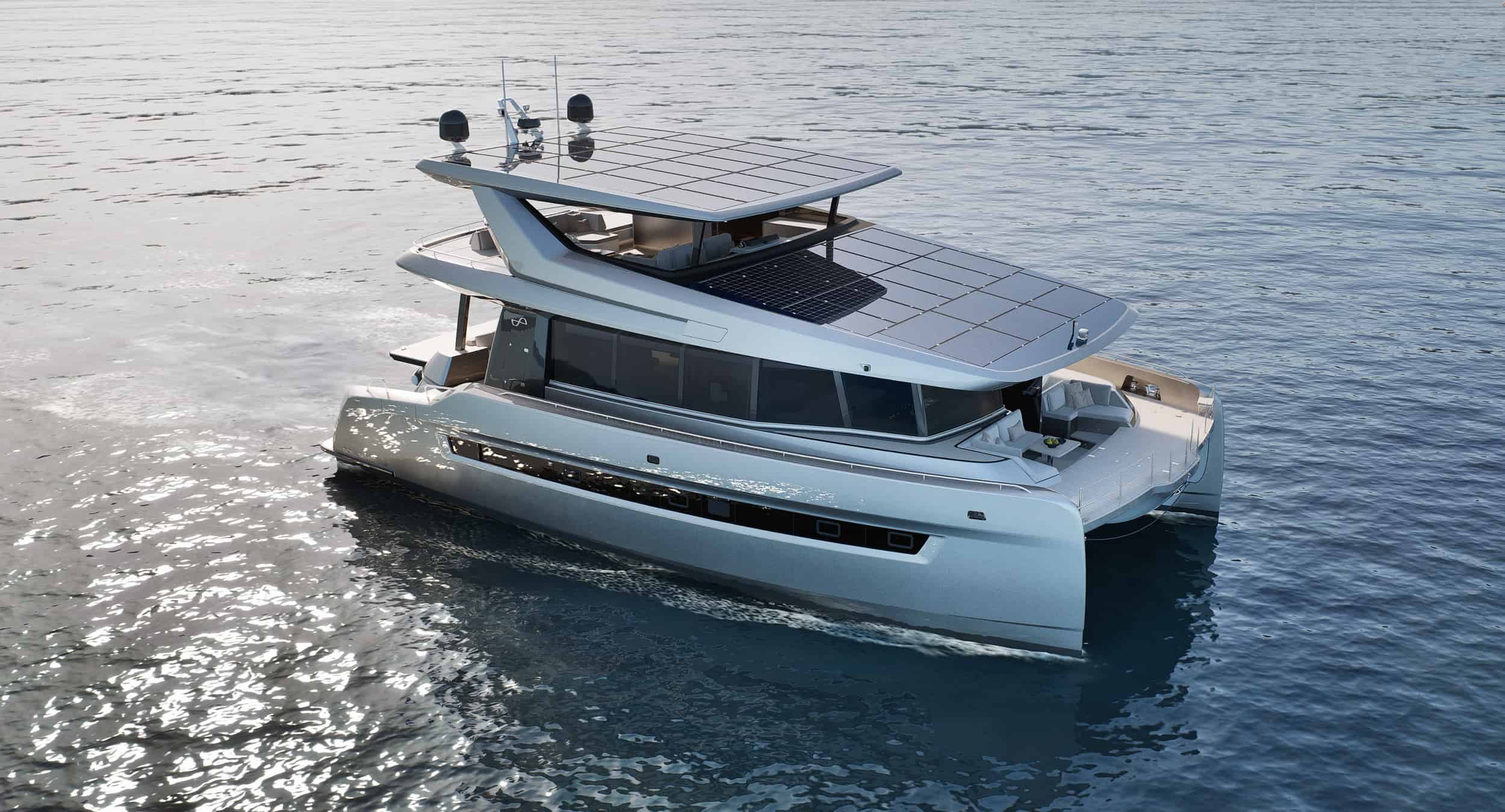
PIONEERS SINCE 2007
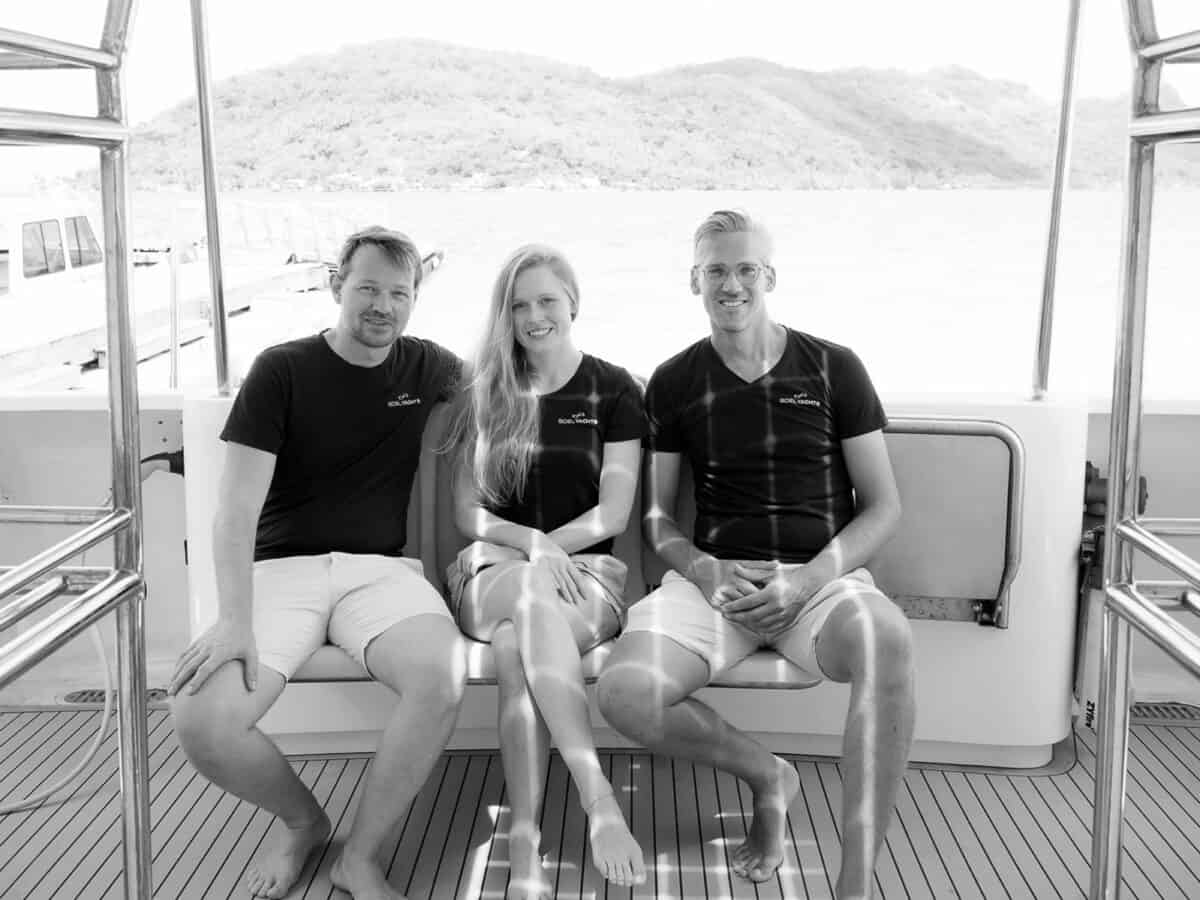
Bringing over 15 years of extensive expertise in electrifying solar electric yachts since 2007, we have been pioneers in the solar yachts industry. Our integral solar electric systems in-house have impressively powered more than 27 circumnavigations of the Earth across the world’s oceans, offering unmatched real-world testing and performance validation for an extraordinary and worry-free sailing experience.
LEARN MORE ABOUT US

INNOVATIVE TECHNOLOGY
At our core, we strive for the perfect balance between cutting-edge technology, purposeful design, and outstanding performance. Our innovative approach combines streamlined hull designs for electric propulsion, engineered in conjunction with our in-house systems, to ensure an exceptional range.
DISCOVER TECHNOLOGY
BOOK APPOINTMENT
It is undoubtedly the most effective approach to directly communicate your desires and preferences with one of our partners. They can provide you with a comprehensive presentation of the available options and take you on a virtual tour of your desired model. Our team eagerly awaits your message today to arrange your personalized appointment, which can be conveniently held either online or in person.
GET IN CONTACT

672 Wine Club
- Motorcycles
- Car of the Month
- Destinations
- Men’s Fashion
- Watch Collector
- Art & Collectibles
- Vacation Homes
- Celebrity Homes
- New Construction
- Home Design
- Electronics
- Fine Dining
- Benchmark Wines
- Brian Fox Art
- Disneyland Resort
- Ka La’I Wakiki Beach
- Kalamazoo Grill
- Raffles Hotels & Resorts
- Sports & Leisure
- Health & Wellness
- Best of the Best
- The Ultimate Gift Guide
How Zero-Emission, Solar-Powered Yachts Entered Boating’s Mainstream
Yacht builders are designing zero-emissions yachts to compete with diesel-chugging rivals. they're so quiet you can hear dolphins swim by., shaun tolson, shaun tolson's most recent stories.
- The 25 Best US Golf Courses That You Can Actually Play Now
- Fore! The 5 Best Golf Simulators to Perfect Your Game at Home
- Justin Thomas on Defending His PGA Title, Golfing With Michael Jordan and His Legendary Man Cave
- Share This Article

For many years, yacht builders adding solar panels to their boats discovered those panels would typically power a few things like the electricity and galley, and if they helped with propulsion, it would only carry a boat so far. In the last few years, new companies and boat-builders have emerged that are proving solar can be the main source of power—a big deal considering that most yachts are solitary creatures that are entirely reliant on a specific form of propulsion. No boaters wants to be 50 miles away from civilization in a turbulent ocean and suddenly see their engines go out. It’s not like they can call AAA.
Related Stories
- JetBlue Is Opening Its First Premium Airport Lounges for Top-Tier Fliers
- Amalgam Debuts Ultra-Detailed Models of the Ferrari 12Cilindri Supercar
The Deep-Sea Submersibles Market Is Thriving Again One Year After the ‘Titan’ Disaster
The problem was that most yacht builders were sticking panels into yachts that were never designed to be self-sustaining. Boyd Taylor realized that several years ago as he was conceptualizing solar-powered catamarans for his company Serenity Yachts . Near the end of 2019, Taylor oversaw the launch of the Serenity 74, with almost 1,200-square-feet of solar panels. Those panels support all of the yacht’s onboard functions, while it cruises at 9 to 11 mph indefinitely.
The yacht functions so capably—using only solar power—because Boyd and his team of engineers started from the water up. They created an electrical system designed to only use solar energy. “We started with the solar system and built the rest of the boat around it,” Boyd told Robb Report.

Soel Yachts is one of the latest builders to introduce a solar-powered catamaran for emissions-free cruising. Courtesy Soel Yachts
Once the electrical system was in place, Serenity Yachts ’ team of naval architects and engineers designed a lightweight boat made of carbon-fiber weave, not pure fiberglass. Taylor says a fiberglass boat that size would weigh 8 tons more. Despite that emphasis on lightweight design, a Serenity Yacht still features interior accents and design materials that mean luxury. Granite countertops, for example, are built around a honeycomb structure, so only a thin layer of granite is needed.
Other boatbuilders have gained traction in the marketplace, as well. Soel Yachts , a Dutch company founded in 2011, recently launched its Soel Senses 48, a 48-foot pleasure craft that can sail at a top speed of 21 mph and cruise up to 56 nautical miles at 14 mph. Like Serenity, the Soel Senses 48 was designed for “high-efficiency electric propulsion,” as the company states—in other words, it was designed from the very beginning with solar power in mind.
Silent Yachts is one of the leaders in the solar-powered yachts industry, having just launched an 80-foot tri-deck catamaran that is powered by more than 1,200 square feet of solar panels.

Serenity’s 74-footer makes use of the catamaran’s wide beam, while adding windows across the entire upper salon. Courtesy Serenity Yachts
In September, BYD Group , a full-service naval architecture and engineering firm in Spain, unveiled a new all-electric, self-sufficient 65-foot coastal cruiser dubbed Eegle. Positioned as a “game changer in the world of eco-friendly motoryachts,” the Eegle is equipped with 323-square feet of solar panels on its hardtop. Those panels, combined with four, 150-kilowatt electric engines, allows the yacht to cruise 1,080 nautical miles at 8 mph.
“Today, solar panels are much more advanced and can be adapted to more surface shapes than in the past, giving us more freedom to install solar panels in more areas,” says Tià Simó, a co-founder of BYD Group.
Beyond offering clean, eco-friendly sustainability, the benefits that an exclusively solar-powered yacht can offer, according to Taylor, are what your senses don’t pick up while on board.

BYD’s master suite shows the design advances that have been made in the last year in solar yachting. Courtesy BYD Yachts
“You’re running a silent boat,” he says. “You don’t have the smell of diesel fumes or the vibrations and rumblings of a diesel engine. You get to smell the salty air and hear the waves slap against the hull of the boat. You can actually hear dolphins splashing in the water. You not only get to enjoy this incredible scenery and enjoy nature in all of its majesty, you get to know that you’re leaving it the way it was when you came.”
Read More On:
- Serenity Yachts
- Silent Yachts
More Marine

This 246-Foot Electric Superyacht Concept Is Designed to Shine Like a Diamond

This New Superyacht Line Wants You to Feel Like You’re Cruising in a Sports Car

The Shipyard That Built the ‘Titanic’ Has Filed for Bankruptcy

Meet the Wine Club That Thinks Differently.
Receive editor-curated reds from boutique California producers four times a year.
Give the Gift of Luxury
Latest Galleries in Marine

Football Season Is Here: The 7 Best Stadiums for ‘Sailgating’ Around the U.S.

The 11 Most Exciting Superyacht Debuts at the Monaco Yacht Show
More from our brands, benny blanco, wiz khalifa and more attend boiler room x pizzaslime pop-up dance party at the supermrkt in l.a., with yanks opt-out looming, cole rounding into shape, ‘alcarràs’ producer maria zamora bestowed the national cinematography award at the 72nd san sebastian festival, ai weiwei sculpture purposefully broken during exhibition opening in italy, the best yoga mats for any practice, according to instructors.

- Green Propulsion
- Renewable Energy
- Energy efficiency
- Sustainable materials
- Eco Insights
- News & Events
- Sunreef News Magazine
- Press About Sunreef

- 60 Sunreef Power
- 70 Sunreef Power
- 80 Sunreef Power
- 100 SUNREEF POWER
- Sunreef Ultima Range
- Sunreef 44 Ultima
- Sunreef 55 Ultima
- Sunreef 66 Ultima
- Sunreef 77 Ultima
- Sunreef 88 Ultima
- Sunreef fleet

- SUNREEF ZERO CAT
- SUNREEF 100
- Sunreef Fleet

- SUNREEF 35M
- SUNREEF 43M
- 49M SUNREEF POWER
- 210 Sunreef Power Trimaran
- Sunreef Explorer
- 40M SUNREEF EXPLORER
- 40M SUNREEF EXPLORER ECO
- 50M SUNREEF EXPLORER
- Superyacht Fleet
Solar Powered Yachts
Solar panels are a fundamental element of today’s quest for responsible energy generation. Used in households, commercial facilities, and power stations across the globe, they are also a vital source of energy for solar powered yachts. With significant progress made over the last years, photovoltaic technology has emerged as the natural energy source with the most exciting growth potential.
Thanks to photovoltaic cells, solar panels absorb sun radiation to generate direct current (DC). When sunlight reaches a solar cell, it causes silicon electrons to move. This motion will start the flow of electricity that is captured by wires and directed to an inverter. Inverter technology is then used to convert it to alternating current (AC) ready to power household appliances.
The solar power systems on solar powered yachts usually consist of solar panels, batteries, charge controllers and inverters. While batteries store the energy obtained from the solar panels, charge controllers prevent batteries from overcharging. Solar catamarans with house appliances on board will usually need to convert the DC energy into AC with the help of an inverter.
Sunreef Yachts produces solar panels in-house and uses a new (patent-pending) technology to integrate them within structural components. The panels are made of the industry’s most efficient cells with a peak performance of 24%.
Thanks to the solar cells’ outstanding flexibility, Sunreef Yachts’ solar panels can be mounted on any surface of the solar powered yacht. As a result, they are integrated with various areas on board, such as hull sides, mast, superstructure, bimini roof or bow terrace to maximize energy generation.
With a thickness below 1mm and weighing around 1,8 kg per square meter (average solar panels will weigh between 8 and 15 kg per square meter), they are one of the lightest solar power systems in the world. In addition, tests have proven that thanks to their advanced integration technique, Sunreef Yachts solar panels have a very high resistance to shock and abrasion. This allows them to be used on any surface, including hull sides.
EXPLORE OUR CATAMARANS
Sailing yachts, power yachts, superyachts, discover the green side of yachting.
SUBSCRIBE TO OUR NEWSLETTER
- Sailing Yachts
- Power Yachts
- Superyachts
- Making a Change
- Green Concept
Copyright © 2024 Sunreef Yachts . All rights reserved.
- Whistleblowing
- Privacy Policy

Sunreef Venture S.A.
Sunreef Yachts Shipyard
ul. Tarcice 6
80-718 Gdańsk, Poland
+48 58 769 77 77

- Green Propulsion
- Renewable Energy
- Energy efficiency
- Sustainable materials
- Eco Insights
- News & Events
- Sunreef News Magazine
- Press About Sunreef

- 60 Sunreef Power
- 70 Sunreef Power
- 80 Sunreef Power
- 100 Sunreef Power
- Sunreef Ultima Range
- Sunreef 44 Ultima
- Sunreef 55 Ultima
- Sunreef 66 Ultima
- Sunreef 77 Ultima
- Sunreef 88 Ultima
- Sunreef fleet

- Sunreef Zero Cat
- Sunreef 100
- Sunreef Fleet

- Sunreef 35M
- Sunreef 43M
- 49M Sunreef Power
- 210 Sunreef Power Trimaran
- Sunreef Explorer
- 40M Sunreef Explorer
- 40M Sunreef Explorer Eco
- 50M Sunreef Explorer
- Superyachts Fleet
Recharge at Sea: Solar Catamarans Harness Sun-Powered Serenity

Just as a residential solar system makes a house independent of an electricity grid, a marine solar panel makes a yacht independent of a fossil fuel powered generator. Catamarans boosted by solar power systems are increasingly in demand in today’s day and age for their increased energy efficiency and reduced environmental impact.
Here is everything you should know about solar catamarans from Sunreef Yachts Eco :
An Introduction to Solar Catamarans
Derived from natural sources, renewable energy is replenished at a far higher rate than consumed. Of these, solar energy is the most abundant renewable energy resource on Earth that may even be harnessed during cloudy weathers. Additionally, because sunlight remains omnipresent, powering a watercraft with solar energy is a fitting concept.
Before we continue exploring the subject of solar catamarans, let us focus on the architecture. The twin hull structure of catamarans translates into a large beam, which provides ample space for solar panels installation. To top it off, catamarans have a fairly shallow draft that produces little to no drag, making them exceptionally energy efficient .
Marine solar panels are currently gaining substantial popularity amongst catamaran designers and manufacturers as a medium of supplying clean energy via a reliable source. Sunreef Yachts Eco is a pioneer in solar catamarans as we believe that the incorporation of a solar power system into yachts births an environmentally friendly yachting solution with a significantly reduced carbon footprint.

The Benefits of Solar Catamarans
The ocean is home to the largest continuous ecosystems; unfortunately, it also remains the most sensitive. Millions of people across the globe indulge in recreational marina and boating activities leaving behind pollution in their wake.
Here are three ways in which solar catamarans rectify commonly occurring hazards for the greater good of the environment:
1. Fuel (oil or gasoline) spills and the discharge of combusted fuels from engines readily contaminates water surrounding the marinas. This aggravates toxicity levels in water, resulting in increased pollutant concentrations in aquatic organisms and sediments.
For illustration, coral reefs, which are a vital source of nitrogen and nutrients for marine food chains and provide shelter for over one million aquatic species, are nearing extinction due to water pollution. Installing solar panels would, without a doubt, decrease the dependency of all types of watercrafts on non-renewable energy sources, i.e., fossil fuels, for operations and increase energy efficiency.
2. Noise from moving gas-powered ships cuts straight to the sea floor and back. These acoustic vibrations transmitting end-to-end affect marine animals to a great extent. Research suggests that human-caused noises result in disrupted behaviours, increased stress, and impaired feeding in marine life, leading to injury and death. Solar catamarans are far quieter than their combustion-driven counterparts; thus, they maintain the oceanic silence vital for the marine life as it enables communication and continuous growth.
3. The elimination of fuels also makes solar yachts more affordable to run and maintain in the long haul. In comparison to fuel powered generators, solar catamarans produce electricity at a lower cost since solar panels obtain power via the sunlight, a renewable source of energy that is present in abundance. But even if your catamaran utilizes both fuel and solar power, you are still to enjoy significant savings on fuel.
Why Power A Boat with Solar Panels
Apart from the obvious environmental factors, solar panels fulfil an important criterion for the oceangoing voyagers who do not wish to be left stranded far from land with a dead battery: unlimited backup power.
On a typical sailing day, there is ample sunlight to ensure the backup battery restores enough power to generate electricity that keeps motors, electrical systems, and onboard appliances running. An added benefit of solar panels is that they continue to generate power even when the catamaran is at a standstill. This energy is stored in batteries for later use.
Furthermore, unlike gas powered generators, solar catamarans do not produce excessive heat, are quieter, and experience little to no vibrations. This allows boat trips to remain pleasant for sailors and vacationers.
Sunreef Yachts combines luxury with sustainability to offer noiseless, vibration-free, and fume-free cruising experiences. Launched under the Sunreef Yachts Eco flag, our sailing and motor yachts are powered using inhouse engineered solar panels that are fully integrated within their composite structure for optimal results. However, an additional asset for sailing solar catamarans remains the ability to combine eco motoring with wind propulsion with the use of high-performance kites.
The Mechanism of the Solar Power System
Classification of solar panels .
There are various kinds of solar panels available for marine boats: adjustable panels, standard panels, and high-energy thin-film panels. While some may argue that having a portable solar panel makes it easier to relocate to where the sun shines the brightest, permanently mounted panels remain ready to go throughout the day.
Despite their long life, standard panels often fail to find a place in the marine industry as they compromise the space availability onboard. Hence, high-energy thin-film panels emerge as winners due to their ability of being permanently embedded on the solar catamaran’s bodywork without restricting living space.
The research and development team at Sunreef Yachts Eco developed the industry’s first composite integrated photovoltaic technology to produce highly efficient, shock resistant, flexible, and ultra-thin solar panels. This in-house engineered solar power system was recognized as a winner of the German Design Award 2022 in the category of Excellent Product Design: Eco Design .
Each solar panel consists of photovoltaic cells, compromising of a positive and negative layer for creating an electrical field. These are made of singly-crystal silicon, a semiconductor that absorbs the radiations of the sun to produce electrical power via the photovoltaic effect. For better understanding: the photovoltaic effect is the process of converting photons (a particle of light) to voltage.
Technical Specifications of Solar Panels
While the average solar panels’ weight lies between 8 to 15 kilograms per square meter, Sunreef Yachts Eco’s solar cells have a thickness below one millimetre and weigh only 1.8 kilograms per square meter. This makes Sunreef Yachts Eco the lightest marine solar power system producer in the solar catamaran market.
Each of the solar cells administered into the Sunreef solar catamarans are ISO 9001:2015 certified and offer a peak performance of ±24 percent, this is 25 to 30 percent more power compared to conventional cells. Despite this, these solar cells do not heat up excessively when receiving sunlight.
Integration Into the Solar Catamarans Structure
The orientation of the sun should be as such as that it hits the solar panels at a 90° angle for best performance. However, with the Earth rotating around its axis to produce a 24-hour day, it is non-viable to ensure the perfect angle throughout the day.
What is more is that the amount of energy produced may also differ depending on external factors, such as a building preventing direct sunlight from hitting the solar panels or light experiencing diffraction from the waterbody before contact. For this reason, it is best to invest in high-efficiency solar cells that generate maximum energy even from limited number of active panels.
Sunreef Yachts Eco makes the most of its solar catamarans’ space availability by spreading its “solar skin” across the hulls, mast, superstructure, bow terrace and bimini roof. Due to this arrangement, the solar panels receive ample sunlight at desired angles from early morning to late afternoon.
At the same time, light rays bouncing off the surface of water to the solar panels, in a process called reflection, also helps generate electricity. These superior performance solar panels possess great strength and durability to survive adverse conditions, year after year.
Generation of Electricity on Solar Catamarans
The crystals in marine solar cells are treated to enable the movement of electrons to generate an electric current. These silicon electrons activate only when in direct contact with sunrays. Instantaneously they start producing direct current (or DC) charges, which is captured by wires and stored in the batteries as energy.
At this point, a charge controller is employed as a regulator for the energy to transfer from the solar panels to the battery. It not only manages the energy load received by the battery, but also prolongs the battery life and performance by ensuring the battery is not overcharged or overloaded. Solar catamarans deploy multiple charge controllers depending on the energy produced.
While the current may be supplied directly to support the electrical demands of the catamaran, if the appliances demand alternating current (or AC), an inverter is added to the cycle to convert the DC to AC first.
Solar Catamarans in Action
But how much energy is enough energy? Working out a catamarans’ energy requirements requires summing up the energy consumed by each device onboard in watt-hours. For better understanding: energy is power accumulated over time, so if power is calculated in watts, energy is watt-hours.
Hence, the first step of installing solar panels dictates an extensive energy assessment of the watercraft. This requires checking the labels of every individual appliance onboard for its typical amp hours and volts used, be it the fridge, fan, or lightbulb. A battery monitor can also help measure energy consumed more accurately.
Depending on the size of the catamaran and the energy consumed, the solar panels size and wattage of power can be precisely determined. Multiple solar panels may be wired together to form a solar array for maximum energy generation. Aiming to fulfil the power needs of your catamaran with solar panels allows you to enjoy a quiet, peaceful anchorage.
Overcoming The Challenges of Solar Catamarans
While yacht solar panels resolve the problem for keeping the batteries topped up without running the generator, solar power systems are faced with challenges of their own. For starters, the harsh weather incurred at sea and saltwater splashing on or immersing the panels accounts for much damage.
However, technological advancements have enabled solar panels to withstand most of these environmental adversities. To illustrate, the installation and electronics linked with solar power systems have now become more resistant to short circuits and corrosion.
Sunreef Yachts Eco employs a unique photovoltaic integration technique in solar catamarans to give the panels extreme resistance to shock and abrasion. Even if the cell eventually cracks, the solid metal foundation remains intact to maintain a high-power output. Furthermore, these solar panels experience no light-induced degradation, no temperature coefficient, and favourable low-light and broad spectral response.
Likewise, the constrains of surface area for marine solar PVs have been addressed with the ability to manufacture customized solar panels. For instance, Sunreef Yachts Eco uses the lightest solar cells in the industry which offer unparalleled flexibility for placement on rounded surfaces of the solar catamaran while others break under pressure. Here solar panels are integrated vertically (on hull sides, flybridge sides, and mast) and horizontally (on front flybridge and bimini) to maximize energy generation.
While the Sunreef Yachts Eco’s solar panel system has a protracted life expectancy, any panels sustaining damage, due to adverse conditions at sea or other geographical circumstances, can easily be replaced. However, it is proven repeatedly that their performance remains unaltered over extended periods of time.
Efficiency of Solar Catamarans Vs. Diesel Yachts
Solar panels make for an ideal energy provider as they ensure the batteries always have power. This makes solar catamarans more self-sustainable and cost efficient to run in comparison to gas-powered ones. Additionally, fewer moving parts in solar catamarans call for significantly lesser maintenance in comparison to diesel yachts.
Boats of all shapes, sizes, and types (sail or motor) can be powered via solar energy to run all onboard appliances on battery. Apart from fulfilling the watercrafts’ day to day electrical usage, utilizing a renewable source of energy extends the durability and reliability of the catamaran.
But most importantly, a solar powered yacht compared to a standard diesel yacht has a significantly reduced carbon footprint. Ideally, with the use of solar power generation on catamarans, you would save 108.5kg of CO2 emissions per day or 39.6 metric tonnes annually.
Why Invest in A Solar Catamaran?
The wind in your hair, the sun on your face, and the sweet smell of the sea are one of the many joys of sailing. However, as an ocean enthusiast, it is crucial to calculate your impact on the environment. On average, the Sunreef Yachts Eco’s solar catamarans account for substantial electricity generation of up to 30 kWh, promoting a positive green footprint.
Today, solar catamarans are trending among yacht owners and shipbuilders as a clean medium to increase energy efficiency and reduce carbon emissions. Additionally, staying true to its legacy of yacht innovation and evolution, Sunreef Yachts Eco continues to work on advancements to its solar panels for improved performance, efficiency, and durability.
Evaluating the Sunreef Yachts Eco Solar Catamarans
Using advanced technology, Sunreef Yachts Eco has engineered ultra-thin, flexible solar panels with the best performance on the market. They are seven times lighter than the average solar power system, enabling them to be fully integrated into the composite structures, including curved surfaces.
The more surface area covered, the more electricity generated. The 80 Sunreef Power incorporates 200 square meters of solar panels (weighing about 360 kilograms) that deliver an astounding 40 kilowatts peak per hour. This setup alone produces solar energy equalling to two generators weighing 800 kilograms altogether.
Hence proven that Sunreef Yachts Eco optimized marine solar panel system outperforms a diesel generator both by weight and performance. Additionally, at reduced speeds, the Sunreef 80 Eco remains fully autonomous, running solely on solar power.
In light of sustainable yachting, Sunreef Yachts Eco has committed to launch over 40 models of its solar catamarans by the end of 2024; this includes a wide selection of sailing yachts, power yachts, and superyachts. Furthermore, Sunreef Yachts has begun commissioning a new range of technologically advanced hybrid ecospeeders, called the Sunreef ULTIMA , that would further extend their solar catamarans line up.
Future Innovations in Solar Catamarans
Despite the distinctive competency of Sunreef Yachts Eco in solar catamarans, the journey of innovation does not come to a halt. To further reduce our carbon footprint, we are undergoing ground-breaking research to redirect excess heat secured from direct sunlight on solar panels to the boilers of our solar catamarans.
Furthermore, Sunreef Yachts Eco is currently developing a concept of an all-new 90 feet sustainable sailing superyacht , called ‘The Zero Cat’ . Apart from sporting a solar power system, this catamaran will use a zero-emission generator to convert methanol to clean hydrogen for unlimited autonomy and greater self-sufficiency.
Frequently Asked Questions
- Why are solar catamarans favorable? Because sunlight remains omnipresent, solar catamarans discern as a greener, cost efficient, and self-sustaining yachting solution . The environmentally friendly passenger conveyance from Sunreef Yachts Eco is consciously built to counter air, water, and sound pollution.
- What is a solar catamaran? A solar catamaran is a twin-hulled vessel powered by solar panels, harnessing sunlight to drive its propulsion and onboard systems, offering an eco-friendly alternative to traditional fossil fuel-powered boats. Powered using inhouse engineered solar panels, solar catamarans designed and manufactured by Sunreef Yachts Eco encourage a positive green footprint at sea.
- Do solar catamarans exist? Launched under the Sunreef Yachts Eco flag, our sailing and motor yachts are powered using inhouse engineered solar panels that are fully integrated within their composite structure for optimal results. The Polish designer and manufacturer has also committed to launch 40 additional models of its solar catamarans in 2024.
- Are there any solar powered yachts? With an increasing demand for solar catamarans with increased energy efficiency and reduced environmental impact, Sunreef Yachts Eco has put to sea several variants of its sailing and power catamarans such as the Sunreef 60 Eco , Sunreef 70 Eco , Sunreef 80 Eco , and 80 Sunreef Power Eco
- What are the advantages of solar catamarans? The installation of solar panels reduces a watercrafts sole dependency on non-renewable energy sources for operations. In comparison to their combustion-driven counterparts, solar catamarans offer noiseless, vibration-free, and fume-free cruising experiences.
- How much is a solar-powered catamaran? With Sunreef Yachts Eco’s philosophy of promoting clean green yachting, the company has released a new range of solar catamarans , the Sunreef ULTIMA , with prices starting as low as €2M* for the 44 ULTIMA ECO . *Please note that all prices listed are subject to change at any time without prior notice.
ULTIMA RANGE
Previous post the revolutionary electric catamarans introduce zero emission cruising, next post dubai international boat show.
Comments are closed.
SUBSCRIBE TO OUR NEWSLETTER
- Sailing Yachts
- Power Yachts
- Superyachts
- Making a Change
- Green Concept
- Energy Efficiency
- Sustainable Materials
Copyright © 2024 Sunreef Yachts . All rights reserved.
- Whistleblowing
- Privacy Policy

Sunreef Venture S.A.
Sunreef Yachts Shipyard
ul. Tarcice 6
80-718 Gdańsk, Poland
+48 58 769 77 77
- THE PRINCESS PASSPORT
- Email Newsletter
- Yacht Walkthroughs
- Destinations
- Electronics
- Boating Safety
- Ultimate Boating Giveaway

The Sunreef 80 Eco Has Launched
- By Yachting Staff
- January 21, 2022
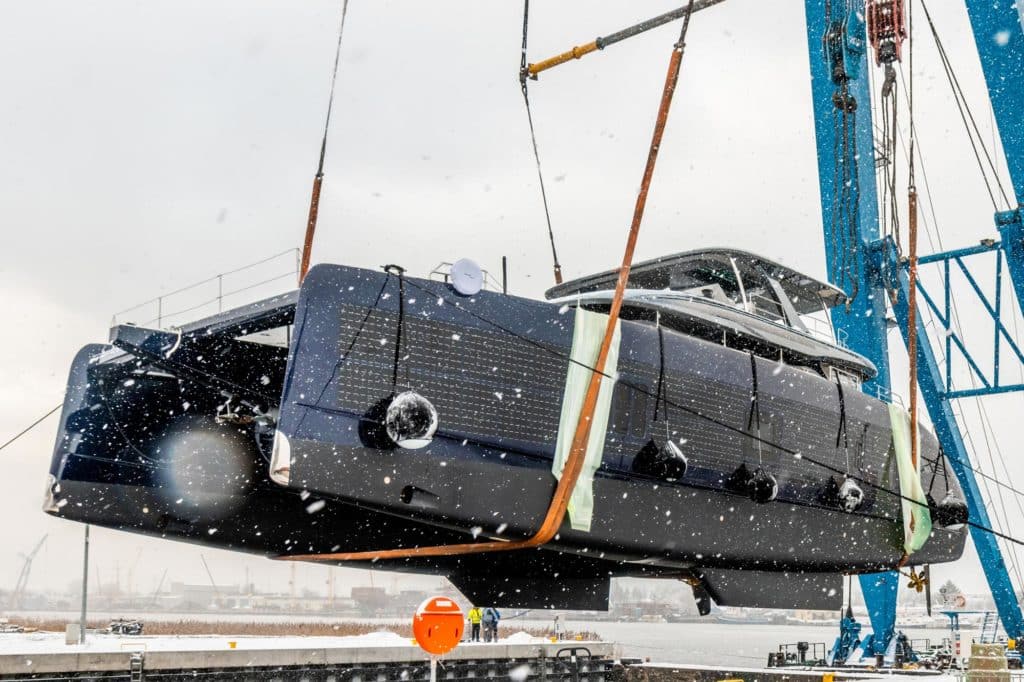
Sunreef Yachts has launched the 80 Eco, an all-electric yacht with ultralight solar panels integrated into the hull sides, mast, superstructure and Bimini roof.
“We take a great step forward with this truly pioneering yacht,” Francis Lapp, founder and president of Sunreef Yachts, stated in a press release. “Renewable energy is the key element in the design of the Sunreef 80 Eco. Thanks to a revolutionary solar power system, hydro-generation and performance sails, the Sunreef 80 Eco provides full autonomy, relying on the sun, water and wind.”
The yacht’s wind-free propulsion comes from twin 180 kW electric engines. Under sail, the Sunreef 80 Eco recovers energy from the passive motion of the two propellers by way of a hydro-generation system.
Are other Sunreef Eco models available? Yes. The Eco line also includes a 50, 60 , 70 and 100.
Take the next step: visit sunreef-yachts-eco.com
- More: Electric , Electric Boats , Electric Yachts , Sunreef , Sunreef Yachts , Yachts
- More Yachts
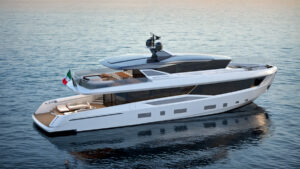
Austin Parker Launches Two New Yacht Series
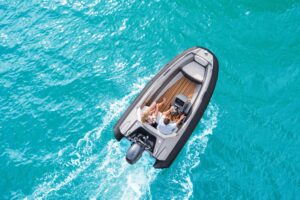
Customize Your Ride: The Argos Nautic GT14 RIB Tender
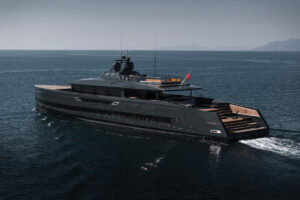
Alia Yachts to Debut SAN Superyacht in Monaco
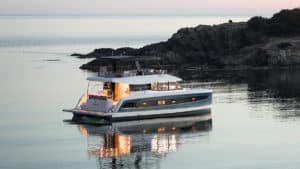
Discover the Top Power Catamarans for 2024
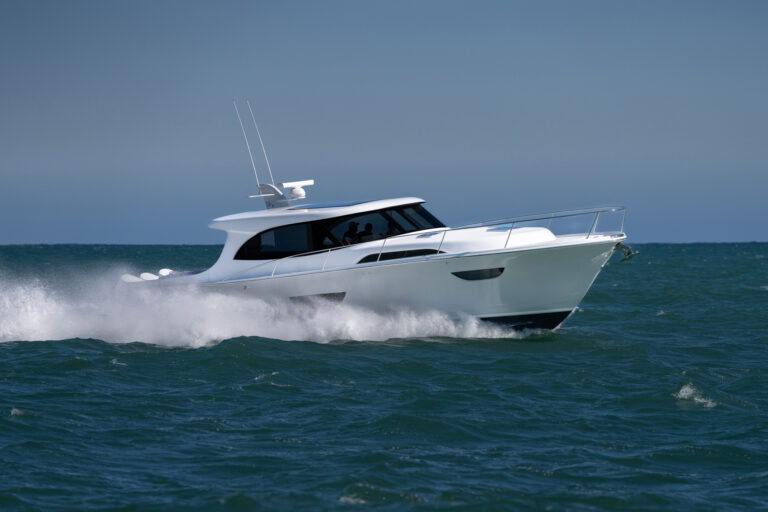
A Standout New Brand
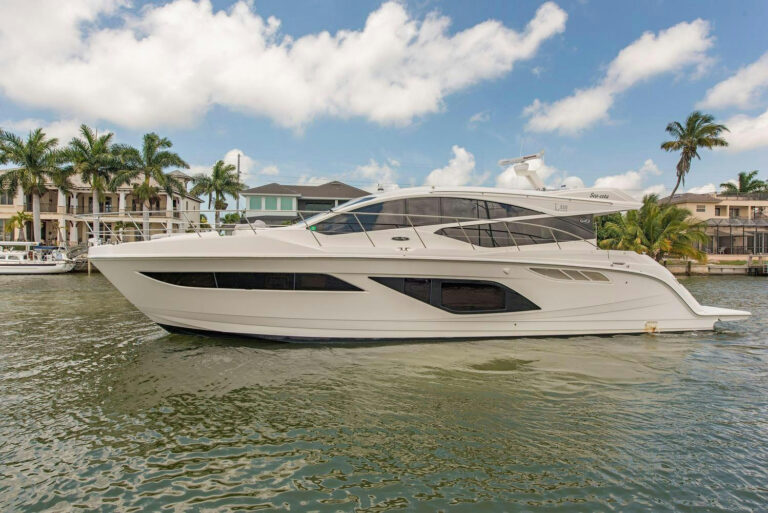
Low-Hour Cruiser: Sea Ray L550 For Sale
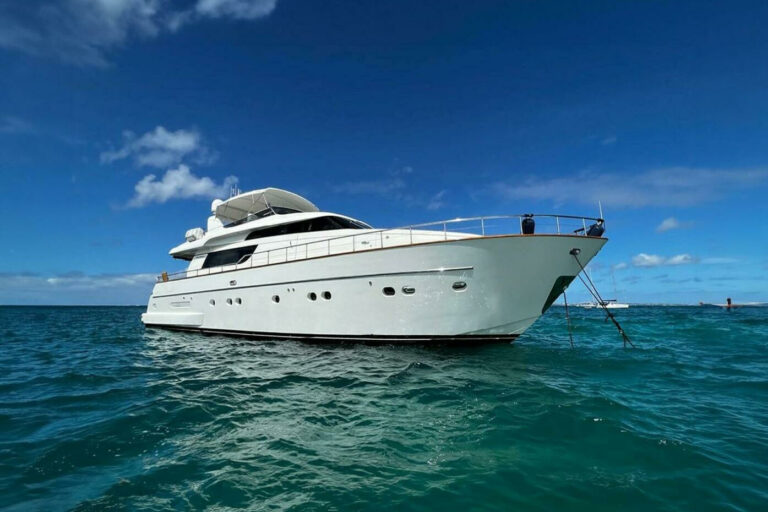
Caribbean Cruiser: Sanlorenzo SL72 For Sale
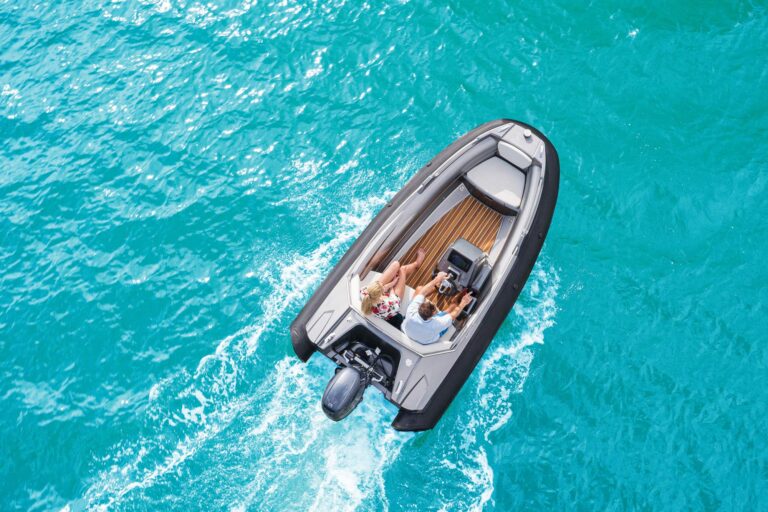
- Digital Edition
- Customer Service
- Privacy Policy
- Terms of Use
- Email Newsletters
- Cruising World
- Sailing World
- Salt Water Sportsman
- Sport Fishing
- Wakeboarding
- Yachting World
- Digital Edition

Wind, water and solar power: how alternative energy has been transformed
- July 15, 2015
State-of-the-art solar power, wind and water generators have transformed the efficiency of alternative power sources. Can we say goodbye to diesel? Rupert Holmes investigates

Imagine a future in which there is never any need to fill up with diesel, buy gas, or top up water tanks and the only constraints are those of needing to stock up with food and maintenance of the boat itself.
It’s a scenario that’s much closer than many realise. The past decade has seen an accelerating pace of change, with technologies that appealed only to a minority, or were prohibitively expensive, now firmly entering the mainstream.
It’s already more than five years since the first of Gideon Goudsmit’s 44ft African Cat cruising catamarans sailed from South Africa to the Netherlands without using fossil fuel, even for cooking, watermaking and hot water.
Although many would baulk at the boat’s 80-mile range under power, this is not a quirky vessel in any other respect – it’s a spacious, fully fitted-out, comfortable cruising catamaran with a high level of equipment. In addition to solar and wind generators providing electrical power for the lightweight design, the boat’s electric propulsion motors were configured to be used as generators when under sail.
And it was by no means the first to do this. When Francis Joyon set the fastest time for a solo circumnavigation in 2007/8, his 80ft trimaran IDEC ll did not have a diesel generator. Similarly, Raphael Dinelli completed the 2008/9 Vendée Globe race without using any fossil fuel.
While few owners aspire to this level of self-sufficiency, incorporating some of these ideas can improve reliability and convenience for more conventional yachts, and may also reduce costs. Perhaps the most persuasive reason of all to fit additional means of generating power is that the presence of multiple charging systems improves a boat’s reliability by introducing a degree of redundancy – if one system fails much of the charging capacity remains intact.
Combining several different technologies can also balance the pros and cons of different power sources.
Thin film solar

A new development that could be the answer to the African Cat’s short range under its electric motors is extremely flexible giant solar panels that can be attached to sails, or even incorporated into the laminate. The durability of this technology was demonstrated at the end of last year by Daniel Ecalard, who used a pair of 3m 2 panels near the head of his mainsail to provide the electrical needs of his Open 50, Defi Martinique , during last year’s Route du Rhum race.
During the race the system stood up to a gale in the Bay of Biscay, in which ten per cent of the fleet retired, and survived the 25-day Atlantic crossing, during which Ecalard logged 4,677 miles, intact.
The system, named PowerSails, was developed by Alain Janet, owner of UK Sailmakers France. Each square metre of the panel is capable of generating 100 watts and, according to Janet, does not need direct sunlight to generate electricity: “In fact, the panels on the sail opposite the sun will generate 30-40 per cent of their maximum output with the indirect and reflected light,” he says.
These panels are made from film that’s 65 microns thick and weighs 100 grammes per square metre. This technology can also be used in other applications – a cockpit bimini shade, for instance, that could generate 1kW on a 50ft yacht.
Prices start at around £700 per square metre of panel, though this is expected to fall as production increases.
Mainstream markets
Janet has produced sails for a Dehler 39 in which a sizeable solar panel is laminated to the mainsail. The technology has also been harnessed by production boatbuilder Arcona, which has announced a version of its 38-footer equipped with an electric engine/regenerating system, sails with solar panels and a big bank of lithium ion batteries.
The boat debuted to great acclaim at this year’s Helsinki boat show, where it won the boat of the show award.
The solar panels in the mainsail are of sufficient size to generate an average of 1,000 watts of power, and the boat has a further 1,000 watts of solar panels. This is sufficient to drive it at four knots under power during daylight hours without taking any charge from the batteries.
Solar power

Almost every aspect of this sector has seen enormous development over the past decade, with worldwide installed capacity having grown by 3,000 per cent since 2005. The resulting economies of scale mean prices have tumbled, while funds are continuing to pour into research and development.
Panels are becoming progressively more efficient, with the best commercially available units now having an efficiency of around 25 per cent, although double that has been achieved in laboratory conditions.
At the moment the thin film panels mentioned above are around 12-14 per cent efficient, but in the future we can expect all types of solar panel to become smaller in area for a given output.
In addition, today’s panels are less susceptible to output drops when in partial shade and give good performance in cloudy conditions. This makes mounting panels on the coachroof, rather than a cumbersome gantry, an increasingly viable option.
Currently solar sells for a very wide range of prices, with most marine grade panels priced from around £200 to well over £500 per 100 watts.

Solar Pros:
√ Improving technology with reducing prices
√ Suitable for a wide variety of boats and conditions
√ Proven ‘fit and forget’ reliability
x Many boats have insufficient space for a enough conventional solar panels
Hydro generators

The transom-mounted generators, such as those produced by Watt & Sea, originally came to prominence in the IMOCA 60 fleet, with the 2008 Vendée Globe race used as a gruelling testbed for the prototypes. They are capable of producing large amounts of power with minimal drag and can be lifted clear of the water when not in use.
The company’s cruising units are rated at either 300 or 600 watts, depending on the model chosen. The larger of these produces 120 watts of power amps at just five knots of boat speed, rising to more than 250 watts at 7.5 knots.
Over a 24-hour period that represents a significant amount of power that could alone run the majority of systems aboard many 50-60ft yachts, including watermakers, pilots, lights, electronics, refrigeration and water heating.
On the downside, hydro generators are relatively expensive compared with solar and wind generators, with Watt & Sea’s prices starting at a little over £3,000. Moreover, they are potentially vulnerable to damage when docking. The latter can be a particular problem in the Mediterranean, where most mooring is stern to the dock.
The Sail-Gen from Eclectic Energy (from £2,000) or the towed Aquair (a little over £1,000) from Ampair are more economic, though less convenient, alternatives.
Another option is a hybrid drive system with a regenerating function via the boat’s main propeller. Advantages include an absence of peripheral parts attached to the transom that may be susceptible to damage, or detract from a yacht’s aesthetics.

√ High power output
√ Impressively low drag
x Transom-mounted types are expensive
x Vulnerable to damage
x Only works when the boat is underway
x Impeller of transom-mounted models may leave the water if boat is pitching in a head sea
x Towed type difficult to deploy and recover
Methanol fuel cells

These small, lightweight units have many attractions for use on board. Most are designed to monitor battery state constantly and automatically start charging once the voltage falls to 12.2V. They are almost silent in operation, with carbon dioxide and water the only exhaust products.
Output ranges from around 3 to 9 amps and more than one unit can be used to achieve higher charge rates. Given that a fuel cell can, in theory, run for 24 hours a day – unlike a marine diesel generator, which is more usually used for only two or three hours – a fuel cell can pump out a useful amount of power, despite the low amp hour rating.
On the other hand the long-term cost of ownership is a drawback. With retail prices of around £2,300-5,000 they are relatively expensive to buy, although installation costs are minimal. Additionally, the platinum catalyst has a finite life of around 5-8,000 hours. As this is by far the most expensive element, it’s clear that fuel cells aren’t yet up to providing power 365 days a year for long-term use.
A further problem is with the fuel, which to achieve the purity required is expensive and generally only available from specific outlets.
At the moment it looks as though fuel cells have more cons than pros for many yachts, although there are some circumstances in which they may make sense. For instance, they are popular on long-distance short-handed raceboats. A fuel cell may also be useful on a boat with a hydro generator that is self-sufficient on power while on passage, but may need an occasional boost when at anchor for long periods to supplement solar and wind charging.

√ Unobtrusive, clean and quiet
√ Easy installation
x Long-term ownership and operating costs
x Fuel not universally available
Wind generators

For several decades these were de rigueur for serious cruising yachts. On paper a decent-sized unit is capable of generating the entire needs of a 45-50ft yacht. However, they also have a number of drawbacks, the most commonly cited being noise and vibration in strong winds.
In addition, most cruising routes maximise time spent sailing downwind, which reduces apparent wind strength, which in turn dramatically reduces the output of a wind generator. Similarly, generating power in many anchorages can also be problematic, as the very shelter sought by the skipper also means that wind speed is generally significantly reduced.
Nevertheless, wind generators can be useful in some circumstances; the important thing is simply to recognise their strengths and weaknesses.
Prices range from small units producing just four amps or so for less than £400 to upwards of £2,000, although for most medium to large yachts £1,400-1,900 will buy a suitable system.

√ Capable of producing plenty of power in a strong breeze
x Noisy and creates vibration
x Output severely reduced in sheltered anchorages and when sailing downwind
x Can be bulky and cumbersome
Typical daily power outputs

Typical power inputs for 12V systems (divide the ah figures by 2 for 24V systems)
Assuming the panels are mounted in an unshaded position, each 100W of rated capacity can be expected to produce, on average, around 33ah of charge per day during the UK summer.
For a yacht averaging 150 miles per day (6.25 knots), Watt & Sea’s 300W cruising model will produce around 175ah per day. This rises to around 275ah per day at an average speed of seven knots, but falls to 120ah per day at five knots average.
These have by far the biggest range of potential outputs, with many units averaging less than ten per cent of their rated output over a full year. That would equate to a mean of around 50ah per day for a model with blades of around 1.2m diameter.
However, there are few average days and a 24-hour period with steady 15-knot breeze would see the same unit produce more than 100ah per day. In a 25-knot wind it would be 500ah.
The daily output of fuel cells is very predictable. For example, a model rated at 5 amps would produce 120ah per day, if run constantly for 24 hours.
It’s worth noting that, as the catalyst nears the end of its life this figure will tend to reduce.

Battery monitors
The more complex a yacht’s systems, with multiple power inputs and outputs, the harder it is to keep track of the battery state. However, a properly calibrated battery state monitor will measure all the power flows in and out of each battery bank. This makes it easy to keep track of power consumed and keep charge levels above the 50 per cent of battery capacity needed to ensure good battery life.
Reducing power requirements
Despite the increasing complexities of many of today’s yachts, new technologies mean that power requirements are steadily reducing in many cases. Whereas only a few years ago the accommodation of a quality 60ft cruiser might have been lit by 400W of halogen bulbs, low-power LEDs can reduce that by 90 per cent.
Despite their growing size, TVs can now draw less power than a couple of 12V lights did a decade ago. Similarly, tablets and smartphones are increasingly used for activities that not so long ago could only be done with a power-hungry laptop.
Pragmatic solutions for cruisers

For most yachts it’s worth combining a number of different types of technology, depending on how you sail and where. Here are some options for a range of different scenarios:
1. Cruising in Northern Europe
Despite a reputation for inclement weather, solar power can be a very viable option here, thanks to long daylight hours and relatively cool temperatures. The latter may sound counter-intuitive, but the efficiency of solar panels reduces at higher temperatures.
Whether wind power is worthwhile may depend on where you’re planning to sail and the time of year. In mid-summer in the southern half of the UK, for instance, the wind is typically less than ten knots for 50 per cent of the time, so wind generators are of limited use. However, in western Scotland towards the end of the season you could generate plenty of power, which would compensate for the reduced solar output.
With the longest passages most yachts will make being 300-400 miles, a hydro generator is likely to be of less use than for boats making longer voyages. An exception might be for those planning to spend a lot of time at anchor and who therefore value the ability to arrive at an anchorage with batteries fully charged.
2. Mediterranean cruising
While many marina-based yachts, with ready access to shorepower, in the western Med appear to have been slow to adopt solar power, the opposite is true in the eastern Mediterranean where there are increasingly few privately owned yachts without an array of panels.
As an example, Alan and Deborah Mackenzie’s Lagoon 410 catamaran, based in the north-west Aegean, has three 100W semi-flexible panels. This has proved fractionally too small for their needs – to power a fridge, freezer, powerful fans and a 19in TV/DVD in addition to the boat’s systems. They plan to solve this with an additional panel.
Owners of monohulls tend to be more restricted by the space available to mount panels, although the new thin-film panels clearly offer a wider range of options. Given the relatively short distances most yachts travel on each passage, the same considerations regarding a hydro generator in northern Europe apply here.
Equally, in most parts of the Med, wind power is not viable for much of the time.
3. Caribbean
Here it would be easy to assume that solar is the best option. However, while it can certainly be useful, as the main sailing season is winter, when daylight hours are restricted, daily output is smaller than many owners expect. Given that the islands are in the tradewind belt, wind generators stand to produce a good output here.
4. Tradewind passagemaking
Here it’s clear that hydro generators (or power generation via a hybrid drive) have advantages and can deliver a good charge. Wind power, however, makes less sense for tradewind sailing, owing to the reduction in apparent wind speed when sailing downwind.
The output of solar will also suffer from the restricted number of daylight hours on a typical east to west Atlantic crossing. There are, however, more factors in favour of solar on a west to east crossing, as it is likely to be at a higher latitude – with more daylight.
5. World cruising
If you’re going further afield combining as many options as possible will yield the best rates of charging over a wide range of conditions. This is exactly the route taken by Jimmy Cornell, founder of the ARC, whose new Garcia 45 is fitted with solar, a Sail-Gen water turbine from Eclectic Energy and a wind turbine.
The water generator will create 50W of power at four knots of boat speed, rising rapidly to more than 250W at 7.5 knots. The wind turbine, from the same company, is also a high-power model, with a 1.1 metre rotor diameter, producing approximately 100W in 15 knots of wind, rising to 235W in 22 knots.
For more information:
www.africancats.com
www.sunware.de
www.solarclothsystem.com
www.wattandsea.com
www.efoy.co.uk
Eclectic Energy: www.duogen.co.uk
www.oceanvolt.com
www.ampair.com
www.hybrid-marine.co.uk
www.victronenergy.com
This is an extract from the June 2015 issue of Yachting World
- United States - English
- United Kingdom - English
- Canada - English
- Australia - English
- Other Europe - English
- Germany - Deutsch

2 Pieces 200 Watt 12 Volt Flexible Monocrystalline Solar Panel

Write a Review
- Create New Wish List
- Description
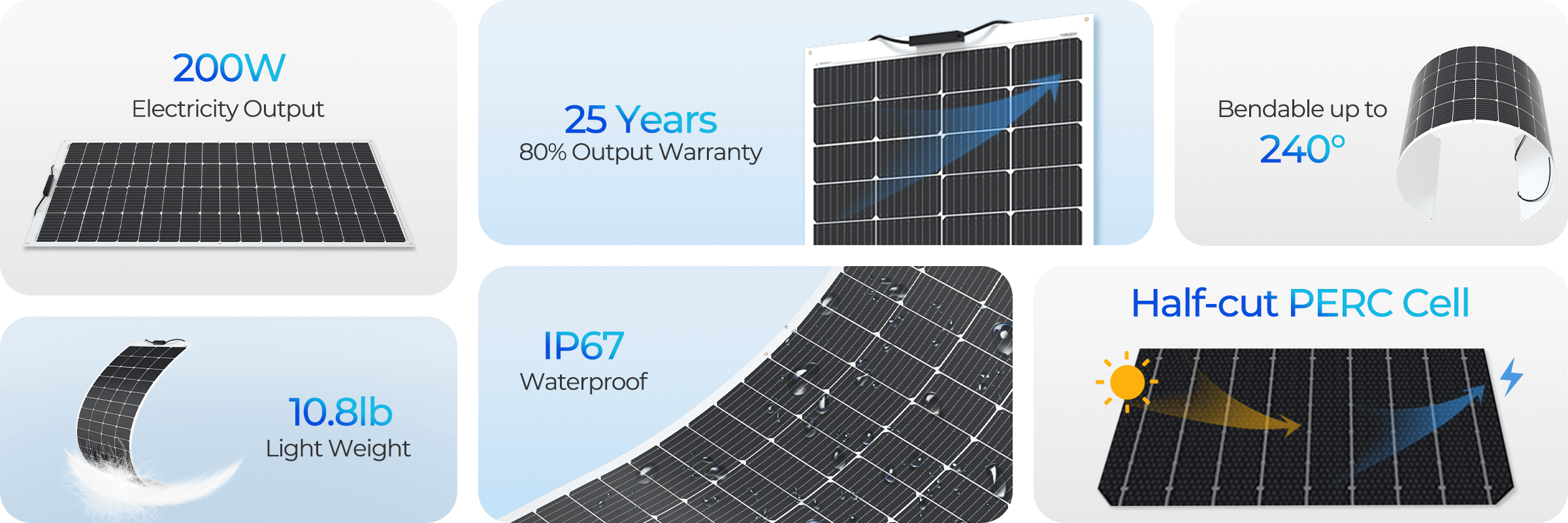
Package Includes
- If you have any questions regarding this product, please call us at 1 (909) 287-7111 or submit a ticket for troubleshooting assistance.
- More questions about your off-grid power system? Learn more from Renogy Learning Center !
| 200 Watt 12 Volt Flexible Monocrystalline Solar Panel
1 x
|
| Module Performance | |
|---|---|
| Operating Voltage | 8-60 VDC (5 VDC for USB Type-C) |
| Power Consumption at 12V | Operating, WiFi On, 100% illumination: 3.2 W Operating, WiFi On, 50% illumination: 2.4 W Operating, WiFi On, 0% illumination: 1.9 W Off, logger still active: 1.5 W |
| Communication | Wi-Fi (IEEE 802.11b/g/n 2.4 GHz) Bluetooth LE and Bluetooth Mesh Zigbee 3.0 (IEEE 802.15.4) RS-485 |
| Touch Screen | 4 inches (480 x 480p) |
| Leveling Range and Accuracy | ±89°, 0.1° |
| Warranty | |
| Model | |
| Operating Temperature | -4℉ to 158℉ (-20℃ to 70℃) |
| Operating Humidity | 0% to 95% RH |
| Operating Altitude | Less than 5000m above sea level |
| Installation | Flush mount or place on a table |
| Dimensions | 4.17 x 4.17 x 1.05 in (106 x 106 x 26.6 mm) |
| Weight | 0.28 lb (128g) |
| Certification | CE, FCC, RoHS, TSCA, BQB, IC-ID |
| Warranty | 2 years |
1. What’s the difference between flexible solar panels and rigid solar panels?
2. can i combine flexible and rigid solar panels, 3.what wattages does renogy offer, 4. can i walk on flexible solar panels, 5. why are my solar panels underproducing, 6. how can i connect solar panels to my electrical circuit (series vs parallel), 7. how many solar panels do i need, 8. will this panel produce power in overcast conditions, 9. do solar panels require maintenance can i wash my solar panels.
- Best Sellers

3000W 12V Pro Pure Sine Wave Inverter with EcoSleep Mode
12V 200Ah Core Series Deep Cycle Lithium Iron Phosphate Battery - Supports Series Connection for 24V/48V Systems

RENOGY 12V/24V IP67 50A DC-DC Battery Charger with MPPT
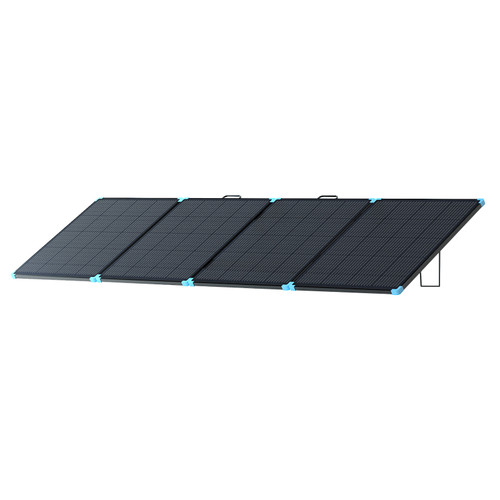
Renogy 400W Lightweight Portable Solar Suitcase

DCC50S 12V 50A DC-DC On-Board Battery Charger with MPPT
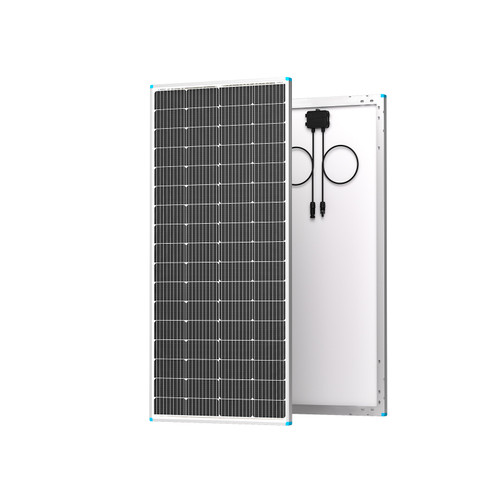
200 Watt 12 Volt Monocrystalline Solar Panel

Renogy 800W 12V General Off-Grid Solar Kit
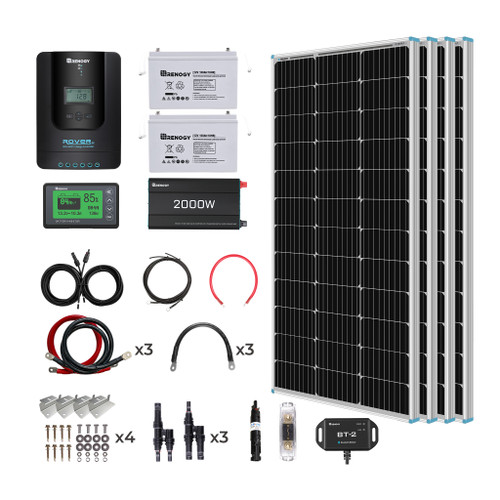
400W 12 Volt Complete Solar Kit with Two 100Ah Deep-Cycle AGM / LiFePO4 Batteries
Be the first to receive our latest news and exclusive deals!
- New Release
- Solar Panels
- Charge Controllers
- Battery Chargers
- Power Management
- Portable Gear
- Wiring & Accessories
- Outdoors & Lifestyle
- Renogy Renewed
- Renogy Sale
- Off-Grid Home
- Residential Grid Tie
- Affiliate Program
- Special Discount
- Off-Grid Solutions for Business
- Customer Cases
- Learning Center
- Success Stories
- Troubleshooting
- Shipping/Warranty/ Return
- Service Center
- Warranty Registration
- DC Home app
- Support Center
- Accessibility |
- Privacy Policy |
- 4G App Privacy Policy |
- Do Not Sell My Personal Information
Create an account with us and you'll be able to:
- Join Renogy Power Plus and earn Rays
- Get exclusive rewards
- Track new orders
- Access your order history
- Save multiple shipping addresses
Create Account

Timeless design meets state-of-the-art technology
More spacious, bolder with premium levels of elegance and comfort. The 80 Series combines our state-of-the-art solar electric drivetrain with unmatched refinement. Her timeless exterior and modern interior features bespoke design by none other than renown Italian yacht designer Marco Casali. Highly advanced hydrodynamics make for an incredibly smooth cruising experience. She can be either configured with a flybridge or as a 3-deck version and can easily accomodate additional crew.
Specification
Deck options, silent 8o 3-deck open.
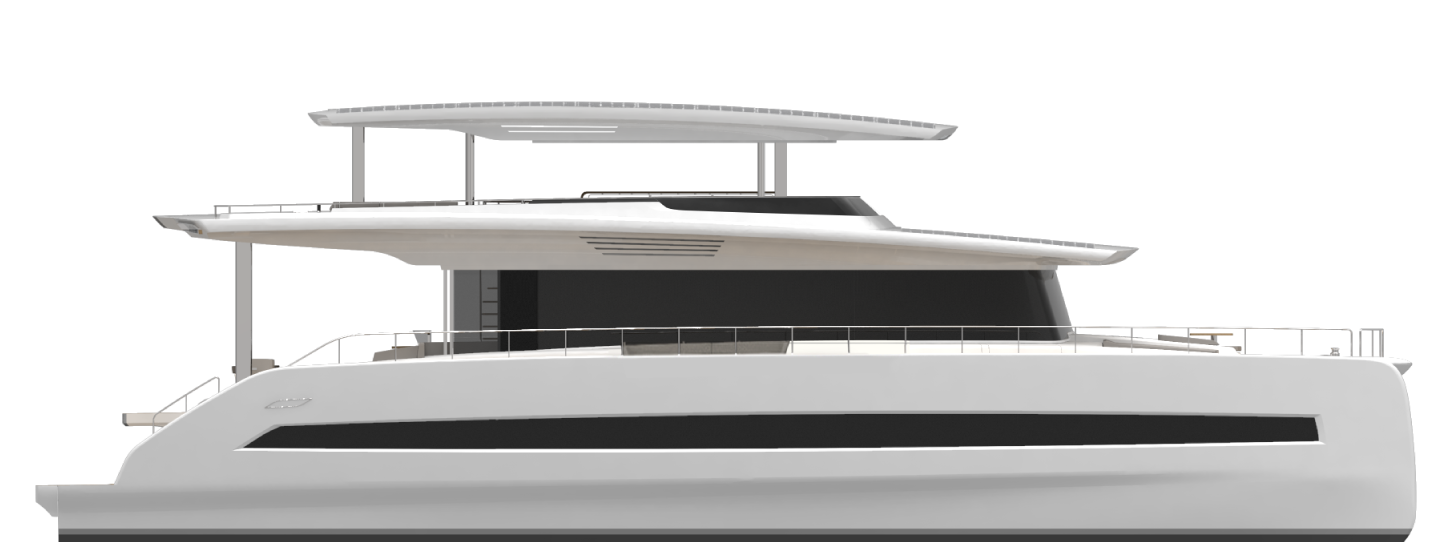
A complete third deck instead of the flybridge provides a total 84 m² of sky lounge space. The open sides create an outdoor ambience which offers a perfect mixture of sun and shade for relaxing owners and guests. Of course, the open third deck can be customized towards the owner´s needs.
Silent 8O 3-Deck Closed
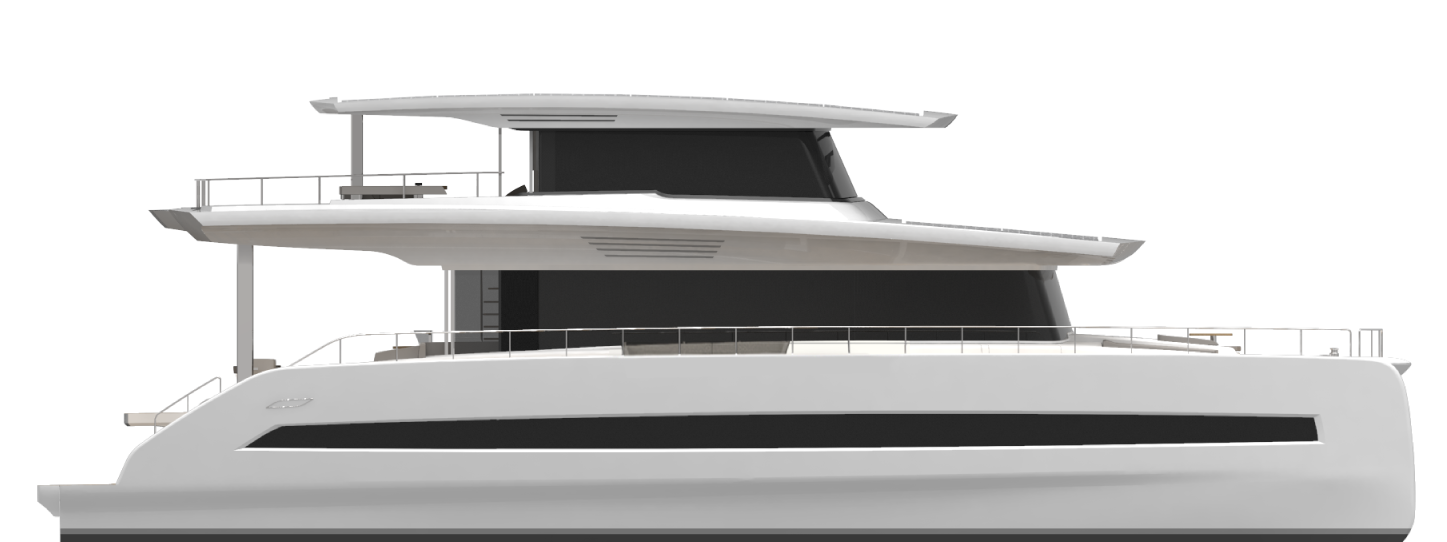
The closed 3-deck version features an owner’s suite with a private 41 m² aft terrace. Those who value sharing their experiences on board can opt for an indoor lounge instead. It is comprised of a 39 m² dining area, fully equipped with a bar and galley, while still maintaining the same terrace in the aft.
Silent 8O Flybridge
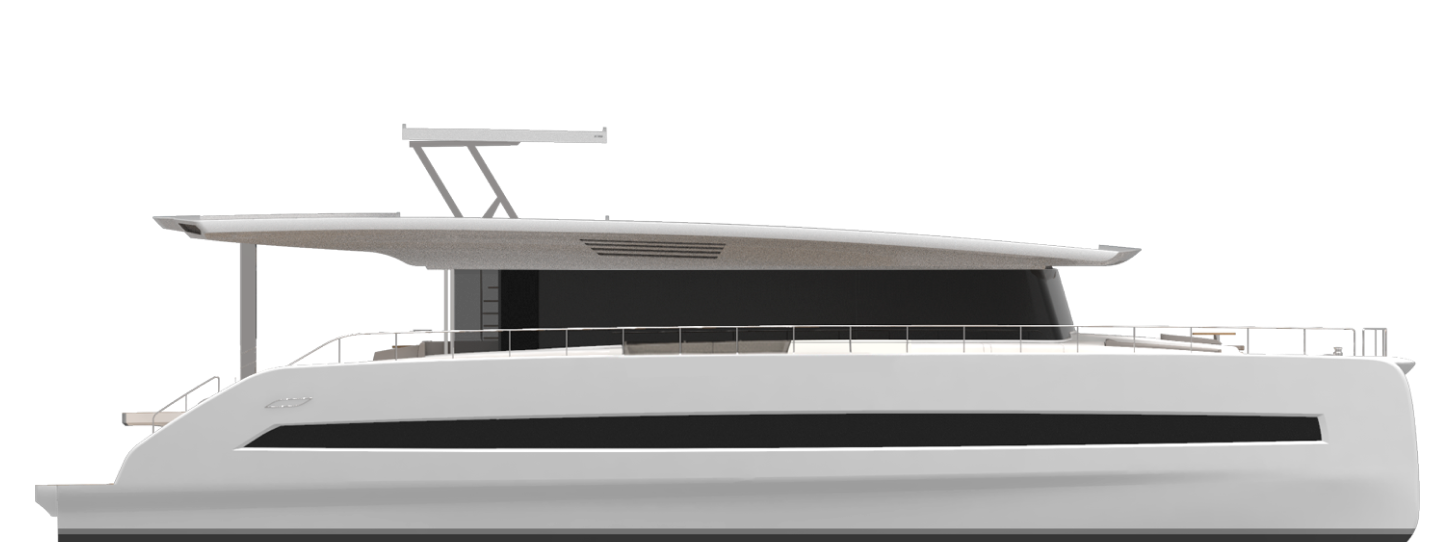
Just as the 60 Series, the 80 Series can also be configured with a retractable flybridge. With 53 m² of space, the flybridge version already offers plenty of room and is equipped with a dedicated helm station to steer the yacht while enjoying the 360° view.
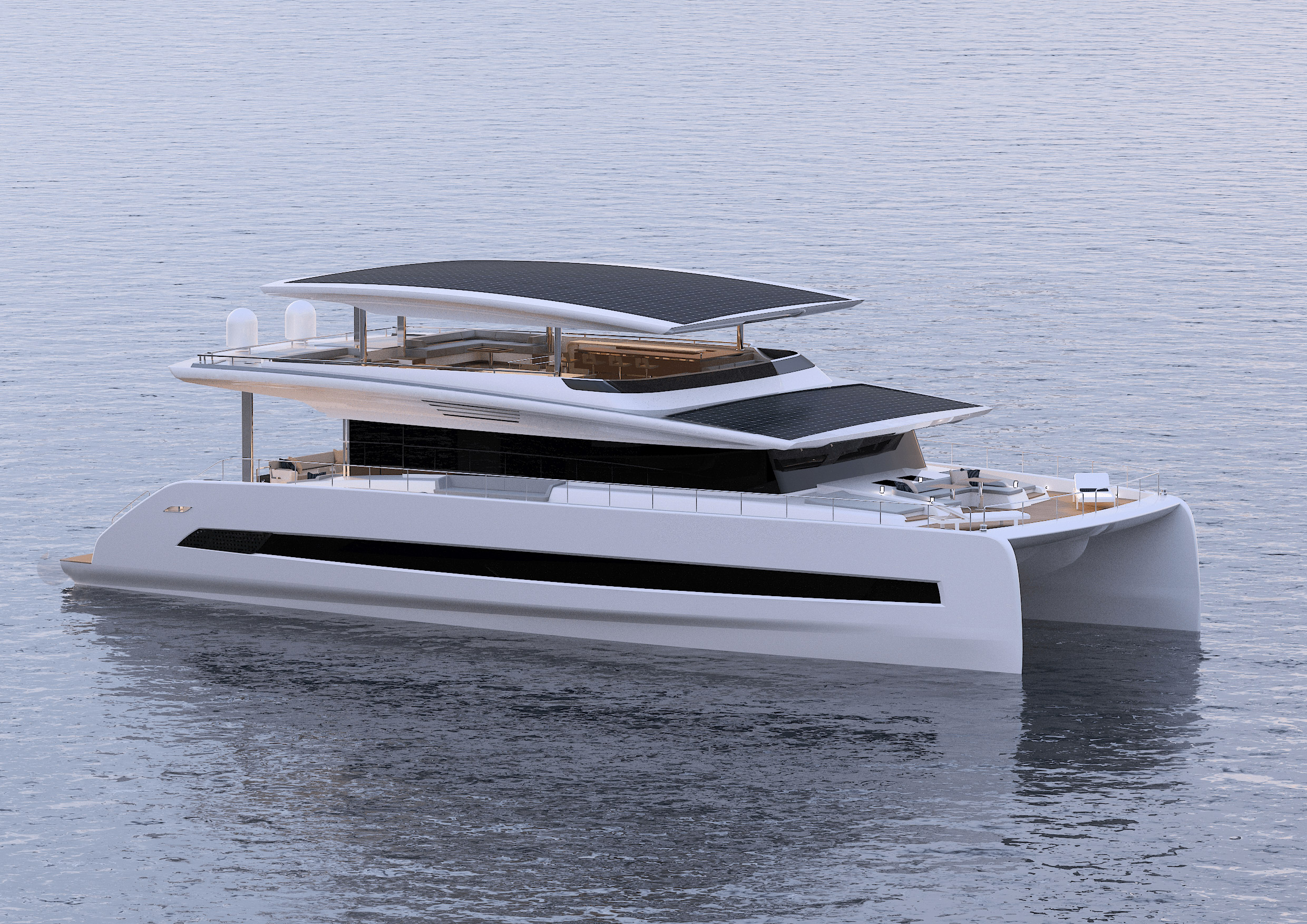
3-Deck Open
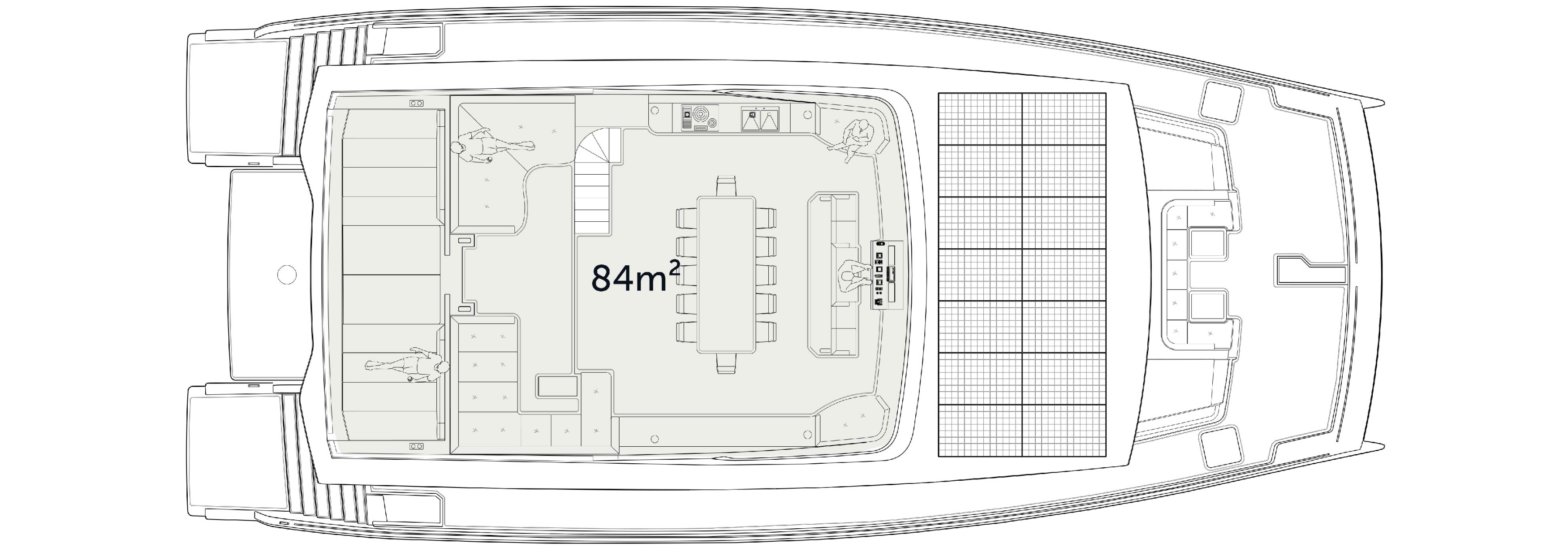
3-Deck Closed
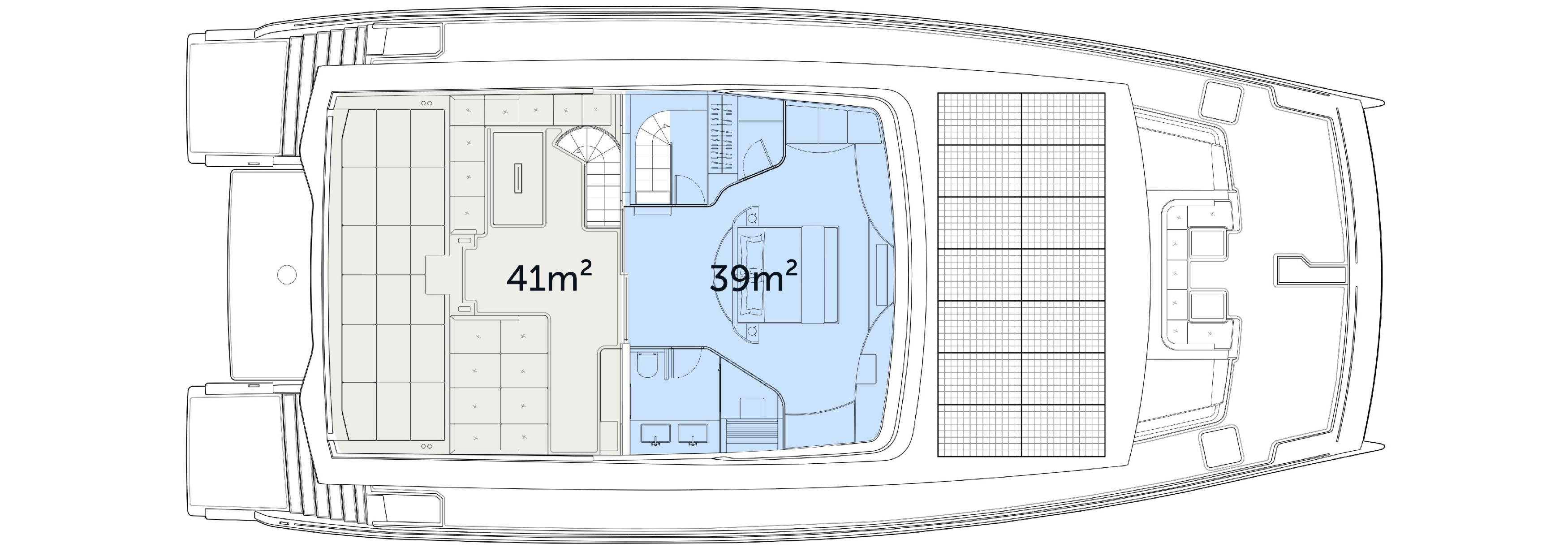
Version 1 (4+2 Cabins)
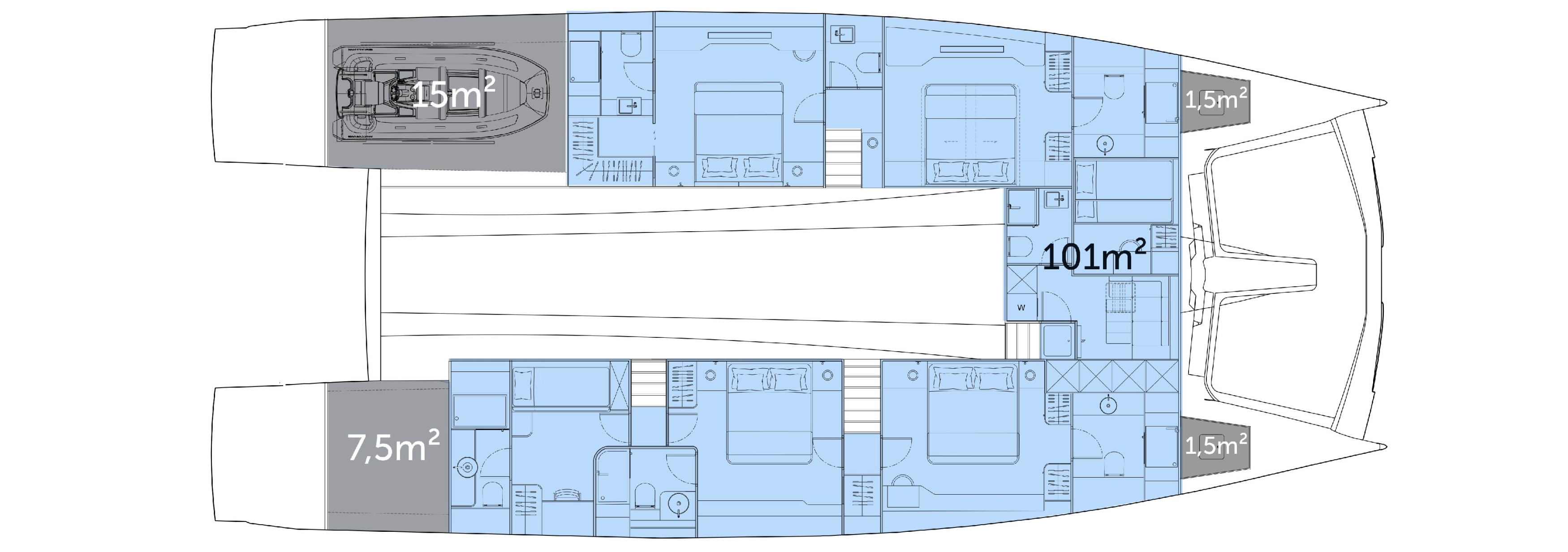
Version 2 (4+2 Cabins)
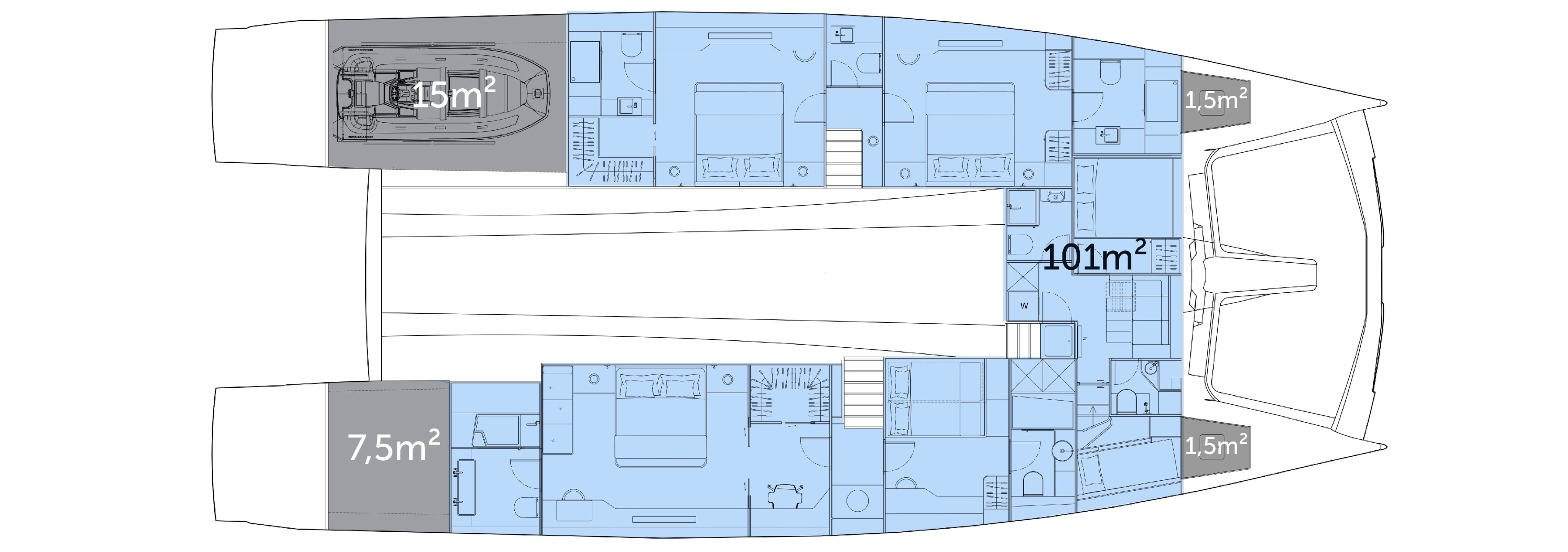
Solar-electric yachting advantages
Unlimited range, noiseless cruising, zero emission, minimal maintenance, powertrains, 8o series highlights.
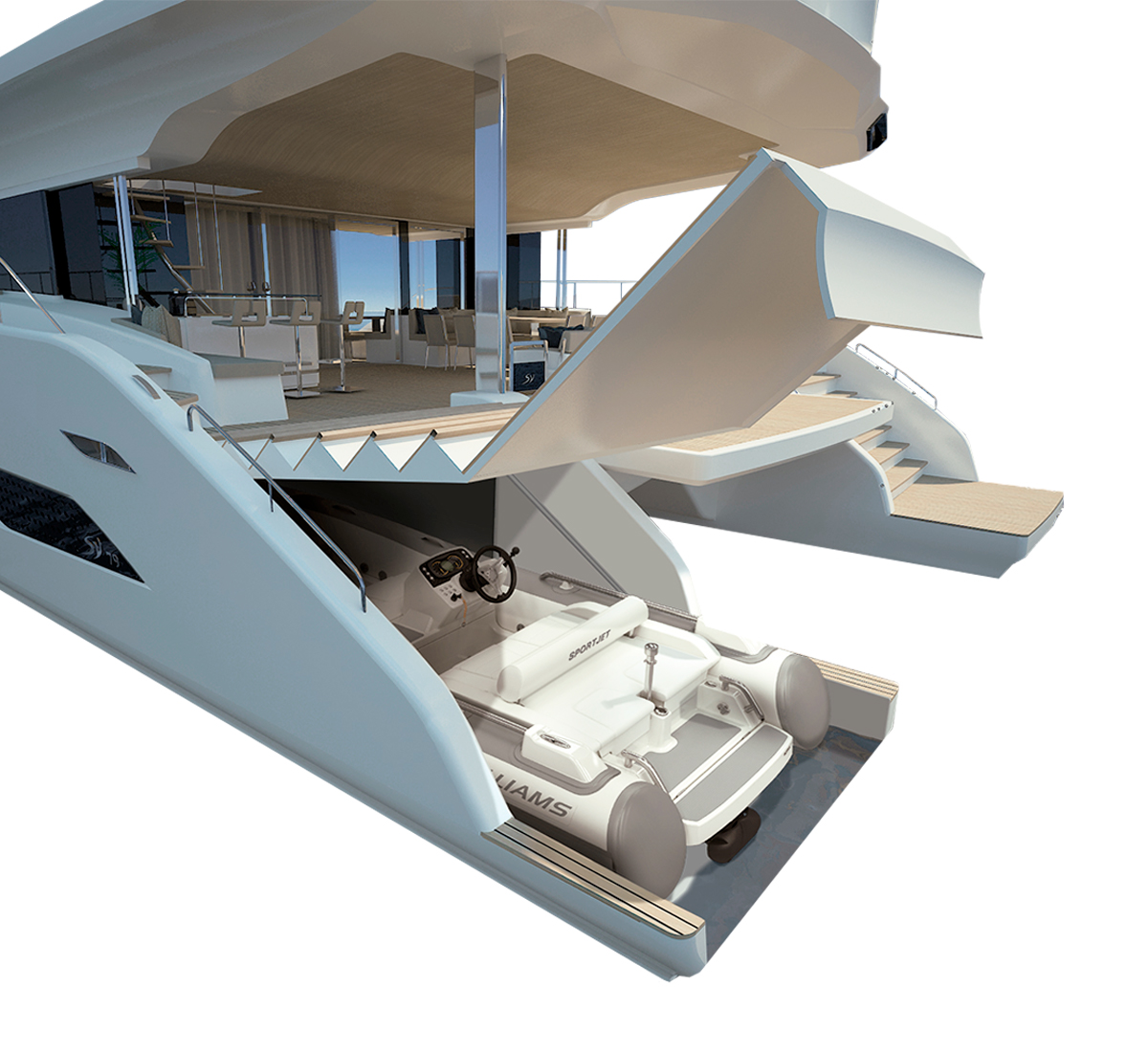
Tender garage
In the aft of the portside hull, the staircase can be raised to reveal a fully enclosed tender garage. It fits tenders with a maximum length of up to 5.20 m, such as the Silent Tender 520, and has a direct charging point to recharge electric tenders with energy produced by the yacht.
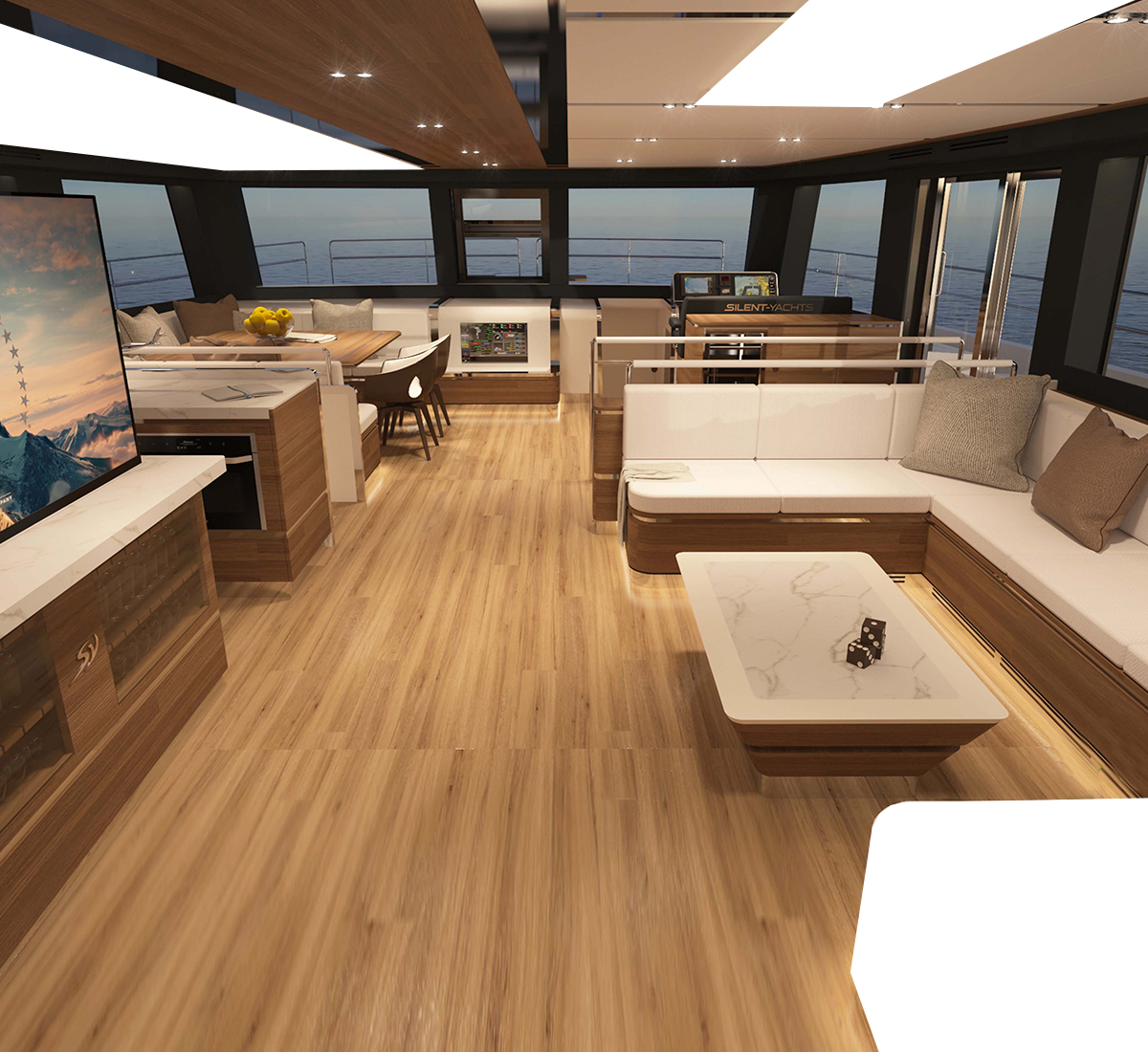
Largest salon area
When compared to other catamarans of similar size, the 52 m² salon of the 80 Series leads with the largest amount of interior space. This creates a lounge like ambiance which offers all the necessities such as a fully equipped galley to enjoy your stay on board.
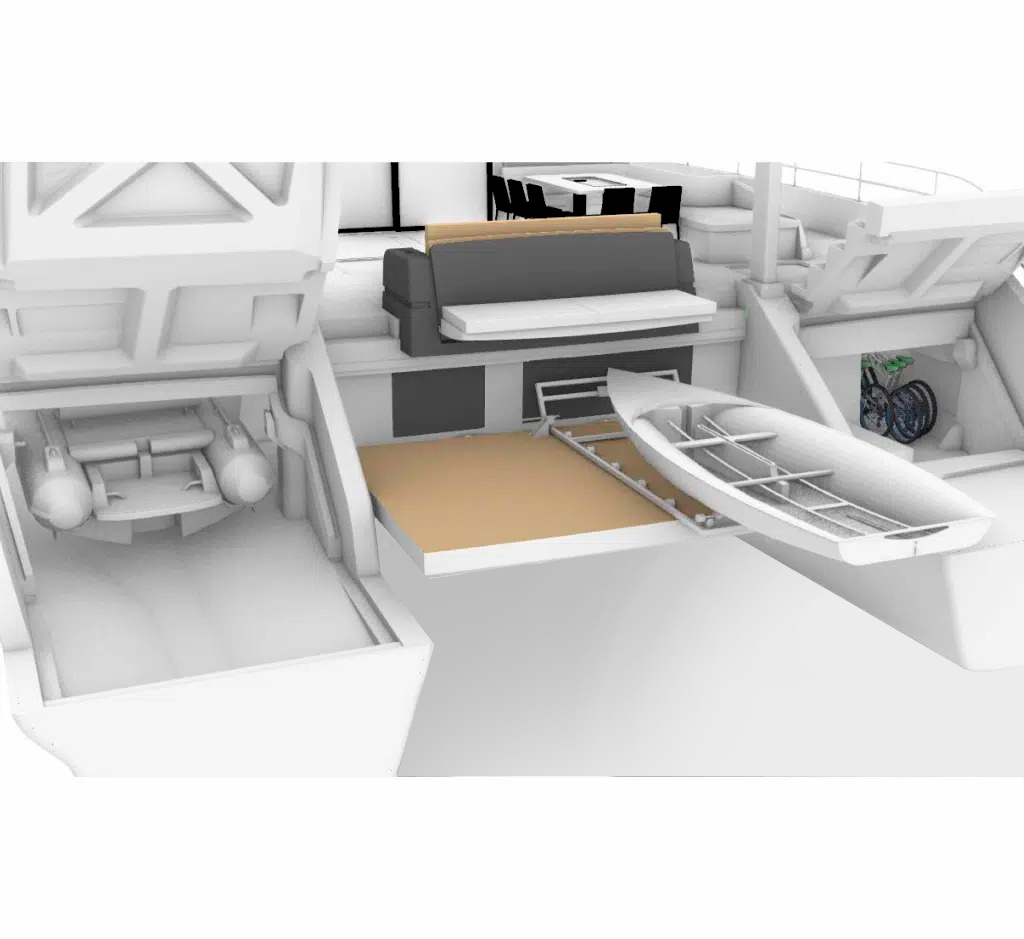
Aft storages
Inside the bridgedeck there is a large storage for water toys. Additionally, in the starboard side there is another storage compartment for diving gear, bicycles and motorbikes which can be accessed through hydraulically liftable stairs from the aft.
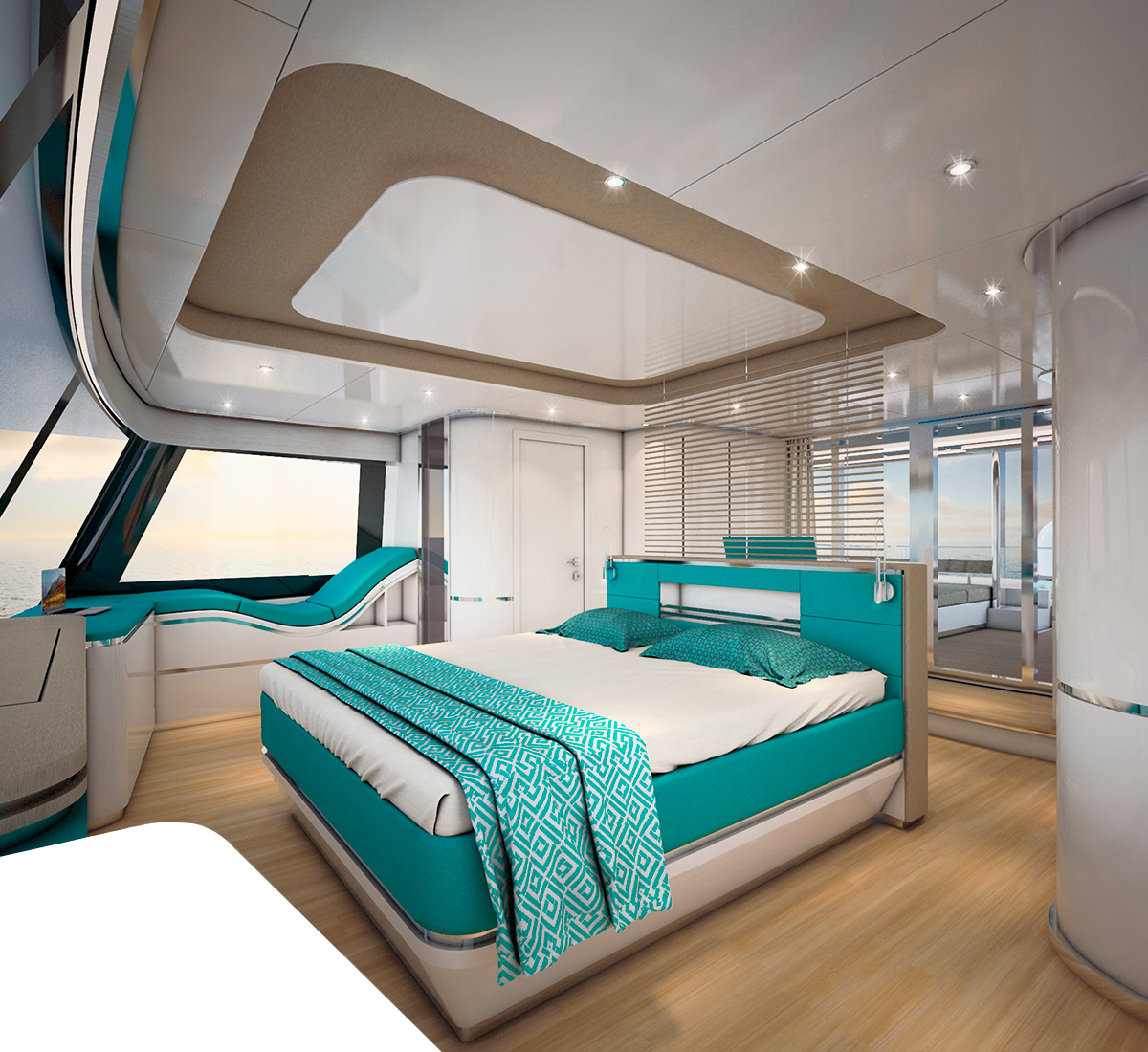
Owner'suite
The choice of an owner’s suite on the 3rd deck adds to the exclusive appeal of the Silent 80. With the entire deck measuring 80 m², it comes with an en-suite bathroom and a private terrace in the aft offering direct access to the sunbed.
If you would like to enquire about this electric yacht and get in touch with a member of our team, please click on the button below.
Other models
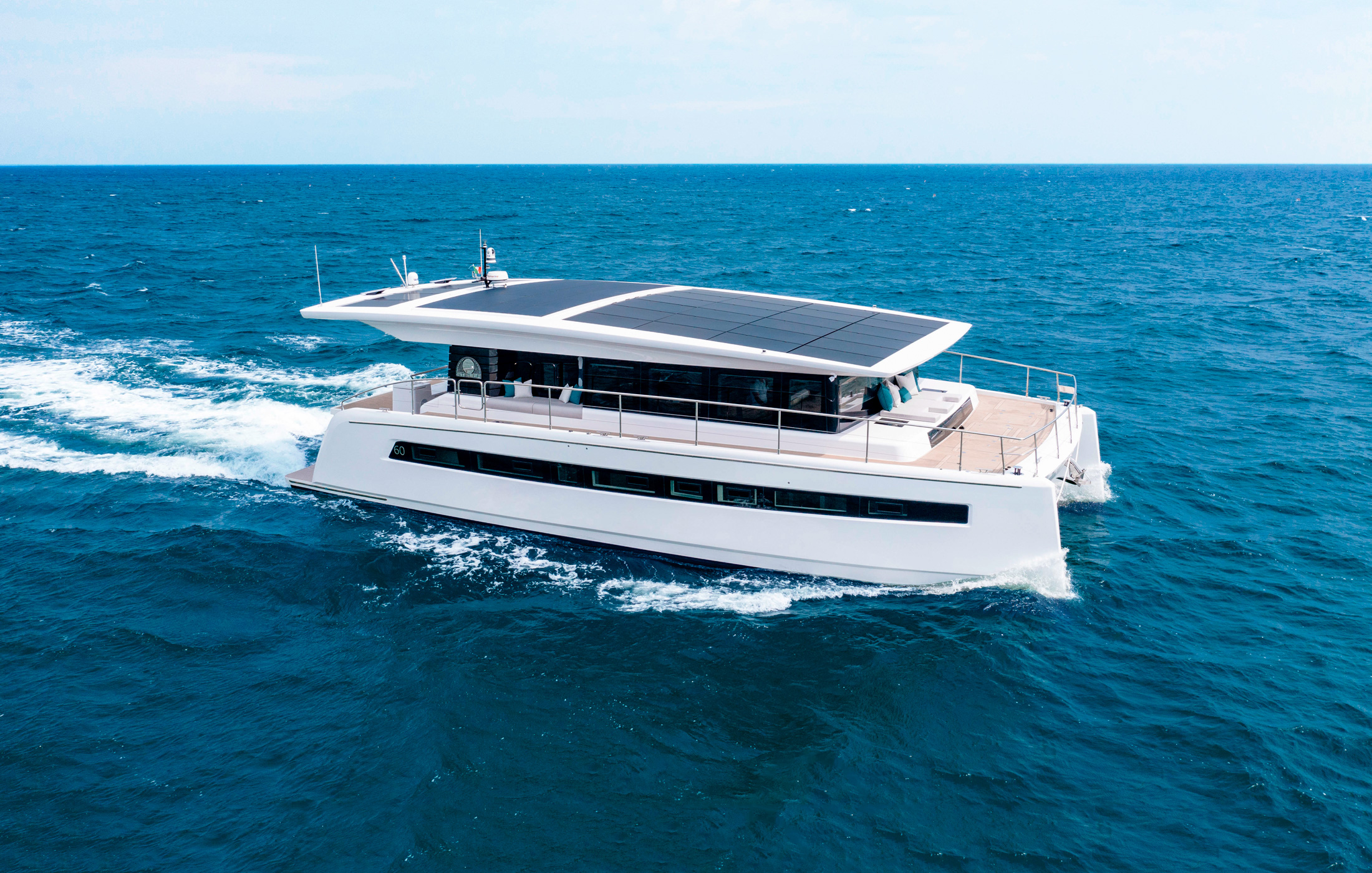
120 Explorer

IMAGES
VIDEO
COMMENTS
Giosolar 1,000W flexible solar panel. Best flexible boat solar panel. Delivering a mighty kilowatt of power, (not far off the amount used by a one bedroom house), this Giostar package comprises ten separate 100W panels, each of which is 1,050 x 540 x 2.5mm in size. Capable of charging either 12 or 24V batteries, a kit of this magnitude is one ...
Our first model, the Silent 64, was launched to the market in 2016, several years before any other shipyard considered the possibility of going electric. Our founders began to research alternative energy sources to power yachts during the mid 1990s. Today, the technology of our in-house developed solar-electric drivetrain has been perfected and ...
Flexible Solar panels. Flexible solar panels, meanwhile, have become increasingly popular with yacht owners due to their versatility and adaptability. While not yet as efficient as rigid panels, they do offer a more eco-friendly and cost-effective option as well as being thin, light, bendable, and easy to install or mounted on almost any surface.
THE AVAILABLE SPACE. In practical terms, a modern 40ft monohull would have the space for around 1,200W of PV panels (cockpit arch, sprayhood top, deck), maybe 1,500W with the addition of a few portable panels for use at anchor. The 1,200W of fixed position solar array could produce around 360Ah on a sunny summer's day (zero shading) or more ...
ALVA Yachts, the German builder of luxury electric solar catamarans and sail boats, has announced it is currently building the world's first fuelless 90ft superyacht catamaran with wings, the OCEAN ECO 90 H2. The first superyacht catamaran to run without fossil fuels and producing zero emission, the OCEAN ECO 90 H2 is designed with luxury ...
A solar-powered boat eliminates the cost of fuel forever. Even if your yacht makes use of both fuel and solar power, you will still enjoy significant savings on fuel. Using Solar Power Reduces Sound Pollution. Though solar-powered boats are not completely silent, they are a lot less noisy than generator-powered boats.
On the smaller 55 and the 64, Silent Yachts currently recommends a 19m2 kite that costs around €25,000 - a fraction of the cost of a new mast, boom, shrouds and sails. "The sail ...
Latest updates and events from the world of Silent. Solar power is the perfect energy source for a yacht. It brings us closer to the beauty and power of nature. Even better than sailing - as it combines the advantages of sailing and motorboating in an unprecedented way. Capturing maximum amounts of solar energy requires a large area of ...
Forty-two solar panels atop the yacht's coach roof make energy and, in turn, propulsion. Alberto Cocchi. The cockpit has a settee and an L-shaped table. A hydraulic swim platform is available in varying widths to handle up to a 13-foot tender without impinging on the platforms on either hull. Silent-Yachts also gets points for good walk ...
The concept of solar-powered yachts is gaining momentum in the boating world. These luxurious vessels are fitted with state-of-the-art solar panel arrays that provide power for all onboard amenities, from lighting and appliances to propulsion. The idea of enjoying a yacht charter while leaving a minimal carbon footprint is now a reality.
Powered by solar panels & wind turbines, our yachts give a complete autonomous range, a robust build, and an array of innovations for an optimum yachting experience. Gilles Reigner Yachts , a pioneering force in maritime excellence, defines the future of yachting by crafting Electric Catamarans powered by 100% renewable energies—harnessing ...
The boldest expression of solar powered yachting yet. Our 120 Explorer brings Silent technology to the superyacht level. Capable to taking you almost anywhere on the water, she pushes our dedication to engineering and innovation further than any other electric yacht before. Just as with our 80 Series, Marco Casali was responsible for the ...
OUR STORY. Bringing over 15 years of extensive expertise in electrifying solar electric yachts since 2007, we have been pioneers in the solar yachts industry. Our integral solar electric systems in-house have impressively powered more than 27 circumnavigations of the Earth across the world's oceans, offering unmatched real-world testing and ...
Silent Yachts is one of the leaders in the solar-powered yachts industry, having just launched an 80-foot tri-deck catamaran that is powered by more than 1,200 square feet of solar panels.
Sunreef Yachts produces solar panels in-house and uses a new (patent-pending) technology to integrate them within structural components. The panels are made of the industry's most efficient cells with a peak performance of 24%. Thanks to the solar cells' outstanding flexibility, Sunreef Yachts' solar panels can be mounted on any surface ...
This makes Sunreef Yachts Eco the lightest marine solar power system producer in the solar catamaran market. Each of the solar cells administered into the Sunreef solar catamarans are ISO 9001:2015 certified and offer a peak performance of ±24 percent, this is 25 to 30 percent more power compared to conventional cells.
January 21, 2022. Solar panels incorporated into the Sunreef Eco 80's hull sides help generate energy from the sun. Power is twin 180 kW electric engines. Courtesy Sunreef. Sunreef Yachts has launched the 80 Eco, an all-electric yacht with ultralight solar panels integrated into the hull sides, mast, superstructure and Bimini roof.
Serenity Yachts. With 110 square-meters of solar panels, the Serenity 74 can cruise endlessly at 7 to 9 knots, while still powering onboard amenities; however, more power may be ahead: "We have ...
Electric yachts | 60 Series | Silent Group. As the successor to the Silent 64 (the first ever solar powered production yacht to cross the Atlantic Ocean during January of 2018), the 60 Series is equipped with the most refined, efficient and clever technology available today. Being a multi-award winner, including the prestigious "Best of Boats ...
The perfect mid sized electric solar catamaran. The OCEAN ECO 60 is an innovation packed solar assisted electric long-range cruiser that will perfectly suit customers who like to cruise and explore while yachting.Designed with luxury, safety and cruising comfort in mind, it is an example of the latest technological developments in the field of self-sufficient yachts surpassing its competition ...
The blue water capable ZEN50 lightweight racing carbon hulls are combined with a huge solar roof for an unrivaled solar power vs. displacement ratio above 1:1 (18 kW / 17 tonnes), making this yacht completely energy self-sufficient. A revolutionary, fully automated, wingsail - by Ayro© - can be added as a range and speed extender.
Hydro generators. For a yacht averaging 150 miles per day (6.25 knots), Watt & Sea's 300W cruising model will produce around 175ah per day. This rises to around 275ah per day at an average speed ...
The Renogy 2 Pieces 200W Lightweight Monocrystalline Solar Panel enhances module efficiency while minimizing its weight. It is the perfect option for any off-grid solar system, especially for transportation applications such as RVs and boats. This solar panel frame features a lightweight substrate and laminate, perfect for outdoor applications.
The 80 Series combines our state-of-the-art solar electric drivetrain with unmatched refinement. Her timeless exterior and modern interior features bespoke design by none other than renown Italian yacht designer Marco Casali. Highly advanced hydrodynamics make for an incredibly smooth cruising experience. She can be either configured with a ...